By David H. Lippman
They were all annoyed. The directive from Jagdkorps (JK) 2 made no sense, but it was clear: all New Year’s Eve parties were cancelled. But to the Luftwaffe fighter pilots affected by the ban, it was ridiculous.
Fighter pilots, whether they were veterans of D-day like Lt. Col. Josef “Pips” Priller, or the newest rookie, were expected to party as hard as they fought. And nobody fought harder than Germany’s fighter aces. Oberstleutnant (Lt. Col.) Herbert Ihlefeld counted his victories back to the Condor Legion in the Spanish Civil War. Oberstleutnant Helmutt Benneman of Jagdgeschwader (JG, Fighter Wing) 53 at Malmsheim had 92 kills, dating back to 1939. JG 54’s Major Erich Leie had 118. And JG 11’s aviators had more than 300 kills, 220 of them split between three aces alone.
Unlike the British and American air services, the Luftwaffe did not rotate its pilots out of combat duty after a certain number of missions or hours in the air, or even transfer them much. There were pilots flying in elite outfits like JG 26 who had been with them since Poland and the Battle of Britain. Now, as 1944 was counting down its last days, combat was harder than ever for veteran and rookie alike. On paper, a Jagdgeschwader like JG 26 consisted of three Groups (“Gruppen” in German), rendered I/JG 26, II/JG 26, and III/JG 26, and could deploy more than a hundred fighters all told. Now the JGs were down to 70, or even 50.
Every day, German fighter pilots battled overwhelming numbers of Allied planes. Many of the Reich’s best pilots were dead or crippled, and the youngsters replacing them were frightened rookies, flung into vicious dogfights with only the sketchiest of training. All bomber production had been cancelled.
Yet, Adolf Hitler was determined to fight on, and the Reich was doing its best to support his twisted determination. V-2 rockets were pounding London, V-1s hammering the port of Antwerp. New Me-262 jet fighters that could fly rings around American and British planes were starting to go into action. But the overall picture was bleak. Unless Germany could turn the tide quickly and dramatically, defeat was certain. If there was any night that German pilots could use a drink, December 31, 1944, was it.
So when Maj. Gen. Dietrich Peltz, commanding Jagdkorps (Fighter Corps) 2, forbade the usual New Year’s Eve hell-raising parties for his fighter pilots across western Germany, the pilots were angry. Lieutenant Oscar Boesch, a pilot in JG 3 at Gutersloh, had to cancel a hot date. JG 2 at Mehrhauzen closed the bar promptly at dusk. At Babenhausen airfield, everyone was too busy to care. They were repairing JG 4’s airstrip. American bombers had turned it into a moonscape on Christmas Eve. By noon on New Year’s Eve, it was ready again for Captain Georg Schroder’s Focke-Wulf FW-190 fighters.
Still, nobody would tell them why the parties were shut down. They were just told to stand by to open the sealed, hand-delivered orders that Peltz’s messengers had delivered. These cancelled passes, closed bars, and ordered everybody to attend mission briefings instead.
Actually, Peltz and his JK 2 staff were not issuing these tough memos just to crush parties and enforce the rules of decorum. New Year’s Eve was simply the date coincident to the weather Luftwaffe forecasters were promising and Peltz’s aviators needed: clear skies and unlimited visibility the following morning. The Luftwaffe needed just such conditions to launch a long-planned counterstroke against the Allies that, if successful, would turn the tide of the air war over Western Europe.
At dawn on New Year’s Day, the Luftwaffe intended to hurl more than a thousand fighters in an all-out surprise assault on Allied airfields in Belgium and The Netherlands, destroying the Royal Air Force and U.S. Army Air Forces on the ground in one swift hammer blow codenamed Operation Bodenplatte (Baseplate).
The plan was in turn linked to Operation Wacht Am Rhein (Watch on the Rhine), Hitler’s massive December counteroffensive in the Ardennes. Wacht Am Rhein was designed to blast through the quiet and thinly held sector, cleave the American and British forces in two, and trap the British against the sea. It would force a second Dunkirk and perhaps even drive Britain out of the war. This desire to crush the Allies in a grandiose manner led to the idea of a simultaneous grandiose air attack.
Bodenplatte was also a reaction to American and British domination of the air over the battlefields and the Reich homeland. Neither Hitler nor his Luftwaffe chief, Reichsmarshal Hermann Göring, liked defensive warfare of any kind. They preferred lightning attacks.
Under Göring’s leadership, or perhaps in spite of it, the Luftwaffe had spearheaded the Nazi blitzkrieg across Europe. But his approach to air warfare was crude in the extreme, tailored more to the days of wooden biplanes and open cockpits than the age of higher technology and fuel-injected engines. When the Luftwaffe began to fail in the skies of Britain, Russia, and Germany, Göring’s star, along with his abilities, dimmed.
On October 26, 1944, Göring summoned his top fighter commanders to Berlin, where he accused them of cowardice. Lt. Gen. Adolf Galland, head of all Luftwaffe fighters, answered his chief with the aggressiveness of one of Germany’s battle legends, a plan called Der Grosse Schlag, or The Big Punch.
Galland’s plan called for 3,700 German fighters, most of them straight off the production lines, to attack the invading fleets of American bombers in one day and two waves of all-out assault. Nothing would be held back. Even generals like Galland would fly the missions.
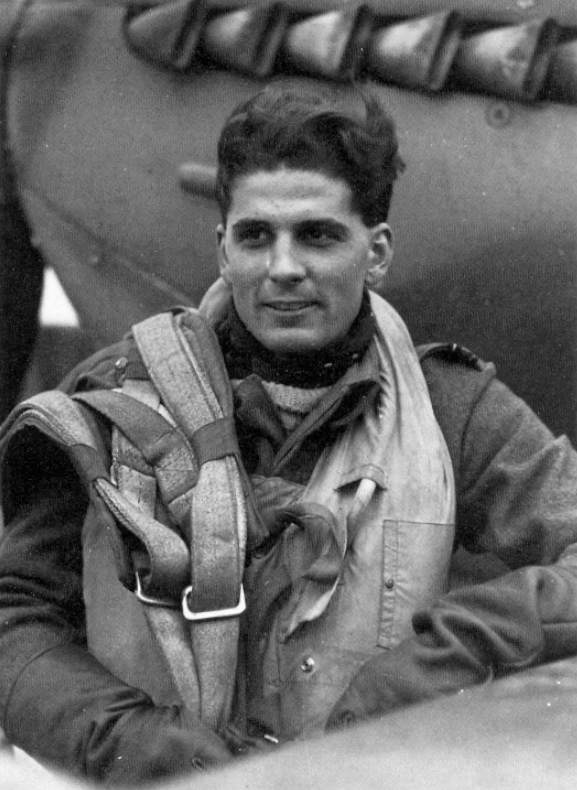
Göring was not impressed. He tore Galland’s medals from his chest and flung them onto a table in front of him. “I’ll put them back on when your damned fighter pilots start shooting planes down again. Unless you bring down 500 Flying Fortresses with your Grosse Schlag, you’ll find yourself in the trenches,” Göring bellowed.
Galland could not assemble 3,700 fighters. On November 2, he sent 500 fighters against 975 American bombers attacking oil plants in the Reich, escorted by 800 fighters, 600 of them the deadly North American P-51 Mustangs, and the Americans shot down 98 Germans, killing 78 pilots. The Americans lost only 50 planes, 30 of them to antiaircraft guns. It was a loss rate Germany could no longer afford. Hitler and Göring were furious.
With the Ardennes plans moving ahead and Hitler having no faith in the Luftwaffe to defend the Reich, the Führer ordered Galland to prepare his fighter reserves to support Wacht Am Rhein. Elite fighter wings like JG 54 Grünherz and JG 26 Albert Leo Schlageter, whose FW-190s and Messerschmitt Me-109s had fought for years, would now move to the Rhineland to back up the big attack. Galland figured his Grosse Schlag was finished. Actually, he was wrong. Göring still liked the idea of a big aerial punch against somebody, and so did Hitler.
Days later, Göring nominated Peltz, a former bomber pilot, to take over JKs 2, which controlled all the fighters on the Western Front, including the planes Galland had been ordered to redeploy. The outspoken and blunt fighter ace was out of the picture, replaced by a pliable and obedient bomber pilot. With most of the Luftwaffe’s bombers mothballed by fuel shortages, Peltz was out of a job. Still, Peltz was neither coward nor fool. He had flown and led Junkers Ju-87 Stuka dive-bombers and other bomber formations since Poland, earning the Knight’s Cross with Oak Leaves and Swords and a general’s rank by age 30.
He put his senior staff in on Göring’s new picture. The Grosse Schlag would consist of a massive low-level air raid on the Allied tactical air bases in Belgium, France, and Holland, more than 30 of them. Junkers Ju-88 and 188 night fighters, flying as navigators and pathfinders, would guide the fleets of fighters to the airbases. This was a concession to the Luftwaffe’s incredible casualty rate. The pathfinders and wing commanders would shepherd rookie pilots to their targets and mark them with flares.
Pilots would fly in on the deck, up-sun, to avoid both Allied radar and ground observers. The fighters would strafe and shoot up the Allied airfields, catching the wings of Supermarine Spitfires and P-51s on the ground. Secrecy was to be absolute.
With the Allied fighters all destroyed, German fighters would dominate the battlefield. Meanwhile, German bombers, including the new Arado 234 jets, would attack Allied columns and airbases, destroying ground forces and tactical bombers.The attack would go in at dawn on a clear and cloudless day. All was dependent on the weather and the Luftwaffe’s ability to husband its resources. The plan was code-named Operation Bodenplatte to remind pilots to fly on the deck, the baseplate.
In reality, neither the weather nor the Allies proved cooperative. As German tanks massed in the Schnee Eifel for the Bulge offensive, American and British bombers continued to pound the Reich. By now, Flying Fortresses and Mustangs were hammering Berlin by day. On December 5, the Luftwaffe attacked an American raid on Berlin. The Germans lost 75 pilots, 53 of them killed, including a group and two squadron leaders. The Americans only lost five planes.
Then heavy clouds and fog socked in the Ardennes and the German border. Neither side’s aircraft could operate in the gloom. But that was good news for Hitler, as he needed an initial spell of vile weather to launch the Ardennes offensive while Allied air operations were suspended. On December 10, he moved to his West Front headquarters at the Eagle’s Aerie, the Felsennest, at Bad Nauheim, 10 miles north of Frankfurt. Two days later, the top generals assigned to carry out Wacht Am Rhein arrived at Felsennest to finally learn about the plan.
A stooped, puffy, and pale Führer shuffled into the briefing room at 6 pm. Hitler’s weak appearance shocked the generals, but he soon regained his usual fire. Claiming the Ardennes offensive would split apart the Anglo-American-Soviet alliance like a thunderclap, Hitler ordered the drive to commence on December 16, the start of a week of poor weather.
Hitler added that Luftwaffe fighter strength now stood at 3,600 aircraft and, without revealing Bodenplatte, said the Allied air forces were in for a massive surprise when the weather did clear.
Actually, Peltz had only 1,500 serviceable planes. Still, they were good machines. The reliable Me-109 had defeated enemies since the Spanish Civil War. Despite its fragile undercarriage (which led to a lot of collapses on the ground) and weak tail, the Me-109G, or Gustav, the current edition, was a highly maneuverable fighter plane.
JK 2’s other top fighter was the Focke Wulf FW-190, which had first appeared in 1942. It was the Luftwaffe’s first radial engine fighter, and it did not gain the fame of the Me-109 because it deployed too late to fight in the Battle of Britain. Despite its heavy-nosed appearance, the FW-190’s BMW 801 air-cooled engine made it a fine interceptor and ground-attack plane.
Least in numbers but not last in performance came 30 to 50 new jet-powered Messerschmitt Me-262s, which were being used for tactical reconnaissance and occasional fighter missions. Fast and maneuverable, the Me-262 could crack through the air at 534 mph. However, problems with the plane’s metallurgy meant that it could break up easily under stress.
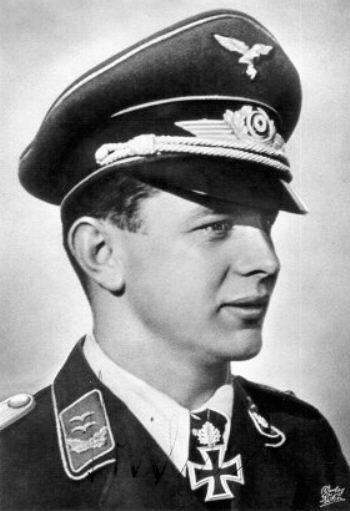
On December 15, Peltz summoned the commanders of his 12 JGs to a secret meeting at JK 2 headquarters at Altenkirchen. There, Peltz briefed them on the plan. More than 1,300 pilots in 33 groups at 37 airbases would hit the Allied targets on a day to be named later. The pilots would only be briefed the night before the attack. Complete radio silence would be maintained in flight until the moment of attack. The attacks would all go in simultaneously.
The targets were all 21 of the Allied tactical airfields in Northwest Europe: 13 in Belgium, six in Holland, and one in France. Most of these airfields were being used by the Royal Air Force or the Royal Canadian Air Force as bases for Spitfires, Hawker Tempests, and Hawker Typhoons. The squadrons based there included Norwegian, Polish, Australian, New Zealander, French, and American outfits.
Peltz handed out aerial photographs of the individual targets to his commanders. These were not to be widely distributed until the attack briefings. If anybody had problems understanding the plan, the orders were simple: Follow the navigation leader and go in with your buddies to attack.
The next morning, 24 German divisions attacked on what the Americans called the “Ghost Front” in the Ardennes. Fog and rain kept the Luftwaffe grounded, but the German offensive crashed through thin American defenses. The Americans were stunned, but reacted quickly, hurling in reserves.
The following day, the drizzle eased and the temperature jumped to 45 degrees. Peltz sortied his planes to support the panzers. He lost 79 of them and 55 pilots to weather and flak, which meant he had to keep the remaining planes back for Grosse Schlag.
Within days, Wacht Am Rhein ran into trouble. The American 82nd Airborne and 7th Armored Divisions blocked the roads at St. Vith in the north, while the 101st Airborne held Bastogne and its seven-road junction in the south. German horse-drawn supply wagons could not keep up with the panzers, and Nazi columns ran out of gas.
When weather cleared over the Ardennes on the 23rd, American and British tactical fighters and light bombers swooped in on the battlefields, savaging armored columns. Flying Fortress and Liberator heavy bombers pounded rail junctions west of the Rhine to cut off the supply flow. Peltz had to send in his fighters to defend the junctions and lost 98 planes and 63 pilots. His planners chafed at the lack of “unlimited visibility” in the forecasts, which were necessary for Bodenplatte’s launching.
On Christmas Eve, the U.S. Eighth Air Force sent the largest mission in its history against the Luftwaffe’s Western Front bases, hurling 2,034 bombers escorted by 700 fighters into action. They were followed by more than 1,200 British Spitfires, Tempests, and Typhoons attacking ground targets on the battlefield. Peltz lost 106 aircraft and 85 more pilots. On Christmas Day, the Allies struck again, and Peltz lost 62 more planes and 49 more pilots. On Boxing Day, the Canadian holiday on the day after Christmas, the Germans lost 60 more planes and 49 pilots. Peltz, trying to juggle reserves for Bodenplatte, could only sortie 400 fighters against the Allies’ 3,500 fighters and fighter-bombers.
Things were worse on the ground. American and British tanks counterattacked at the tip of the Bulge at Celles, cutting up the 2nd Panzer Division within sight of the Meuse River. Lt. Gen. George S. Patton’s hard-charging U.S. Third Army hooked up with Bastogne on Boxing Day, breaking the siege.
Circumstances seemed to dictate that the desperate air operation might not even get started. On December 27, weather socked in most of the Mighty Eighth in England, but the RAF’s Typhoons and Spitfires still pounded German troop concentrations in the Ardennes. Peltz lost 50 more planes and 36 pilots. Looking at his maps that afternoon, Hitler ordered a second offensive in Alsace on New Year’s Day to take pressure off the Ardennes—and Göring to guarantee air support.
Göring was elated. As soon as the weather broke, Bodenplatte would be launched.
On December 28, Peltz started holding back his fighters. If he held the line on losses, he estimated he would at least have 800 planes for Der Grosse Schlag, backed by 30 Me-262 jet fighters. But December 29 turned out to be Der Schwartz Tag, the Black Day, for JK 2, when 2,300 Allied planes swooped in on the Ardennes battlefields. Peltz sent in only 130 fighters but still lost more than 40 of them. Five of them fell in one battle to a single Canadian pilot, Flight Lt. Dick Audet of RCAF 411 “Grizzly Bear” Squadron, flying his first combat mission.
Behind the front, 1,315 American bombers, with 572 Mustangs flying escort, pounded rail marshaling yards and bridges.
On December 31, the skies cleared somewhat, and the Mighty Eigth slammed oil refineries at Hamburg and Milsburg. Peltz’s planes stayed out of the battle. Some 137 of his machines flew over the Ardennes. That afternoon, Peltz studied fresh weather reports and fired off the first of three coded signals, designed to fool Allied radio-interception teams, to launch Bodenplatte.
Shortly after the parties were cancelled, commanders summoned their pilots for the big briefings. Each JG had three or four Jagdgruppes occupying one airfield each. At airfields and airstrips across northwest Germany, pilots in leather jackets and flight suits got the word. Lt. Col. Johann Kogler used a table-top sand model to brief his pilots on their target, the RAF base at Volkel, Holland. Major Helmut Kuhle, examining the detailed plan and model, said, “There’s really nothing that can go wrong. It’s foolproof!”
However, Pips Piller and the veterans of JG 26 were less impressed when Priller brief his top men at the JG’s headquarters, Furstenau Middle School. They had to split their JG’s groups in half and hit two airfields at Brussels, Grimbergen and Evere. Priller remembered the old military dictum: never divide your forces, and was worried. JG 11, under the one-eyed Lt. Col. Guenther Specht, however, was looking forward to the morning’s attack. The pilots of JG 1 relished having 20 of KG (j) 51’s Me-262 fighters at their airfield at Twenthe for the morning.
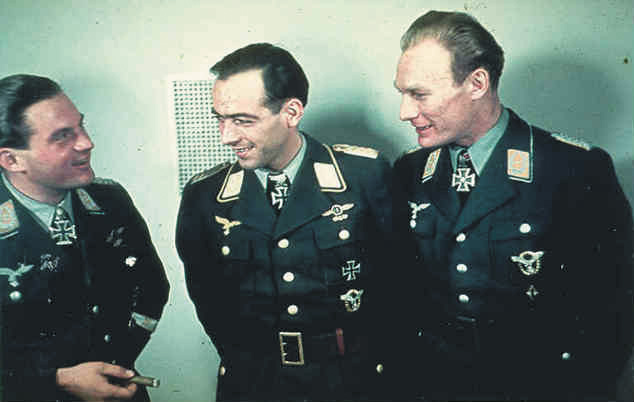
Lieutenant Colonel Herbert Ihlefeld and his JG 1 pilots also studied tabletop models. While JG 1 had veteran pilots and jets to help, they had little experience or practice in low-level attacks.
JG 27 had different problems. Heavy fighting had worn it down. The I/JG 27 was down to 16 Me-109s, most of them overdue for engine overhaul. The II/JG 27 had only 12 fighters. Despite the support of JG 54’s Gruppe IV and its FW-190s, JG 27 was in parlous shape. Major Ludwig Franzisket amalgamated his two battered groups into one and held off on briefing his tired pilots until dawn.
JG 4’s main problem was its moonscape airfield at Babenhausen. Hard work repaired the airfield, and most of II/JG 4’s FW-190 fighters and all of the pilots were ready to go. On the other hand, I/JG 4 had only 10 serviceable Me-109s, while IV/JG 4 had only 20 of its 40 Me-109s ready to fly.
JG 4’s Commander, Major Gerhard Michalski—an ace with 70 kills, many of them over Malta—gave his men a simple briefing: “Mission: low-level attack on Le Culot Airfield. The wing is to form up over Bingen.” Pilot Horst Thanaan noted that the rookie pilots were the most excited about the planned attack.
JG 77 was just as ready but had the same problems of young pilots and few machines. Some had less than 30 hours in Me-109s and had never done anything but formation flying. Many of its planes were badly damaged. The new boss, Major Erich Leie, tried appealing to his men’s pride in being the elite “Red Heart” Squadron. The appeal worked. While the pilots slept, the ground crews worked all night, and by dawn, 100 Me-109s were ready to fly.
JG 53 lacked current photos of its target, Metz-Frascaty, the only one in France, but it had good radio intelligence from chatty American pilots and ground control. The III/JG 53 would take out the base’s flak guns, while II/JG 54 and IV/JG 54 would chop up the USAAF’s 365th Fighter Group’s three squadrons of P-47 Thunderbolts. Lt. Col. Helmut Bennemann told his pilots to come in on the deck, strafe the field, then pull up in stall turns, whip around, and do so again from the opposite direction.
On the other side of the line, Hitler’s words went unheard by the men of the British 2nd Tactical Air Force and the U.S. Ninth Air Force, under Lt. Gen. Hoyt Vandenberg. Most pilots had spent the day flying tactical missions to bomb rail lines, troop concentrations, and supply convoys. After a hard day of air battle, nearly all were ready for a break and celebrating the New Year looked like a good way to relieve stress.
The Allied tactical air forces that were spearheading the drive on Germany were a tough, experienced, and powerful force. The 2nd Tactical Air Force (TAF) was commanded by Air Vice Marshal Sir Arthur “Maori” Coningham, a veteran aviator and tactical air commander. He had pioneered air-ground cooperation and showed great energy and leadership. Thanks to him, 2nd Tactical Air Force’s wings and squadrons of British, Canadian, Australian, New Zealander, French, Polish, Norwegian, Belgian, and Dutch fliers were a harmonious and effective group.
The 2nd TAF was a large but highly mobile force with 2,000 planes scattered across 27 airfields. These planes were organized in three groups, the 2nd Tactical Bomber Group under Air Vice Marshal Sir Basil Embry, 83rd RAF Fighter Group under Air Vice Marshal Harry Broadhurst, and 84th RCAF Fighter Group under Air Vice Marshal L.O. Brown.
The 2nd TAF’s ground elements were very capable of quickly following the advancing armor to establish new temporary airbases. But with the Allied offensive stalled for the winter, 2nd TAF had built up more permanent facilities around existing airfields at Brussels, Antwerp, Eindhoven, and Volkel. When the Ardennes offensive broke out, the U.S. Ninth Air Force planes on the north side of the German offensive were placed, like American ground forces, under Field Marshal Sir Bernard Law Montgomery’s command, which in turn put Coningham’s 2nd TAF in charge of these American squadrons. The paper shuffling caused no changes in the American operation.
The long drive east had caused problems—airfields were overcrowded and antiaircraft guns had been shifted to the V-1 attack routes. With air supremacy pretty nearly complete, camouflage netting had been among the items left behind in favor of fuel and ammunition.
In any case, morale was high in the 2nd TAF and Ninth Air Force as 1944 trickled down to its final few days. The German counteroffensive in the Bulge had given the Allied pilots new targets and plenty of work. On a daily basis, American and British fighters and fighter-bombers were pounding German columns and supply lines. Pilots, ground crews, and supply teams were functioning well. So were the aircraft. The primary attack planes were the British Hawker Typhoon and American P-47 Thunderbolt.
With its huge air scoop, the Typhoon proved a perfect ground-attack machine, armed with two 1,000-pound bombs or eight 25-pound armor-piercing or 60-pound high explosive rockets, which could slice through German tanks. A single Typhoon rocket could put a tough German Panther tank out of action. The rugged P-47, known to its pilots as the “Jug,” packed eight .50-caliber machine guns and could also haul two 1,000-pound bombs into the air.
The main Allied fighters—the Supermarine Spitfire and the North American P-51 Mustang—were legends of the sky. Most Spitfires were Mark 14 machines with new Rolls-Royce Griffon engines, fast enough to keep up with German V-1s. A Mark 14 Spitfire was the first to shoot down a German jet, doing so on October 8, 1944. The Mark 16 Spitfire, which still used the Merlin engine of Battle of Britain fame, was primarily a ground attack fighter, and an effective one.
The other top Allied fighter, the Mustang, was a happy combination of American aeronautical design and the British Rolls-Royce Merlin engine. The culmination of propeller-driven fighter design, the P-51 had it all—range, punch, maneuverability, and stunning looks. The British also had a less well known but equally potent fighter in the Hawker Tempest, a derivative of the Typhoon.
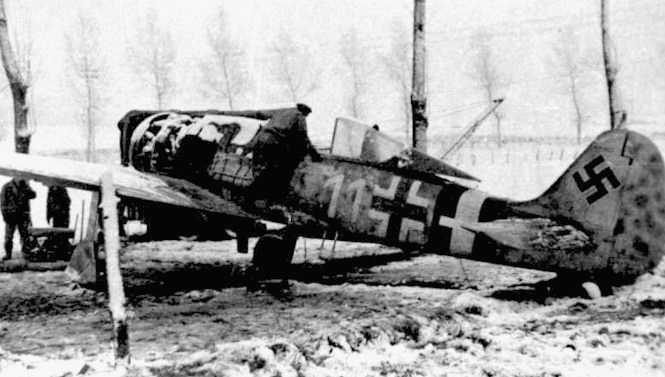
Other planes familiar to aviation enthusiasts populated the 2nd TAF, such as the De Havilland Mosquito, the twin-engined “Wooden Wonder” that could serve as tactical bomber, reconnaissance plane, and night fighter. The 2nd TAF also operated the Consolidated B-25 Mitchell medium bomber of Doolittle Raid fame, older Vickers Wellington bombers for reconnaissance, and the usual motley collection of transports, trainers, and utility aircraft. Among them were Field Marshal Montgomery’s personal Douglas C-47 Dakota transport and Prince Bernhard of The Netherlands’ private Beechcraft.
The knights who flew these aircraft were the equal of their superb steeds. British squadron leaders like Wing Commander Johnnie Johnson, the British commander of 127 RCAF Wing at Brussels-Evere (B-56), were experienced veterans of the Battle of Britain and after Johnson finished the war with 38 kills.
Their American colleagues were just as skilled. On New Year’s Eve, Lt. Col. John “J.C.” Meyer, commanding 352nd Fighter Group based at Asch Airfield (Y-29) in Belgium, shot down a German Arado 234 twin-engine jet reconnaissance bomber, the first
p-51 pilot to do so. With 22 kills, he was already one of America’s top P-51 aces.
On his way back to Asch, Meyer thought about the increasing number of such German reconnaissance missions and decided that the enemy was planning an attack. Asch, which was also home to the P-47s of the 366th Fighter Group, was a possible target. Meyer knew that the two groups were set for a mission on New Year’s Day, which would leave the base unprotected. Concerned, he wanted to sortie a dawn defensive patrol of P-51s on New Year’s Day, just in case.
It was a busy New Year’s Eve for the entire 2nd TAF. Flying Officer (FO) Ed Flanagan and his buddies in RCAF 440 Squadron at Eindhoven (B-78) were preparing for a 7 am low-level rocket sweep in the Ardennes the next day. Flanagan was also preparing to head to England in the second week of January for his wedding to Renee Taylor at her family’s church in Yorkshire. Flanagan and his pals, who had lost eight buddies on Christmas Eve to flak, reviewed their mission profiles and hoisted a couple of belts of schnapps at the small bar in the convent in which his unit was billeted. Then he hit the sack early. So did the pilots of 3 Squadron and 486 New Zealand Squadron at Volkel (B-80), who were set for an 8:55 am armed reconnaissance over Paderborn.
Another Eindhoven outfit, the 39th Reconnaissance Wing, which flew clip-winged Spitfire Mark 14s, was eagerly looking to try out its new machines on armed reconnaissance over the Rhine. Unlike other wings that had to live in tents, 39 Wing was based at the prewar Eindhoven passenger air terminal—heated billets and hot food. The wings based at Eindhoven also got to use the German-built dispersal areas hidden by pine trees and the vast 4,000-yard runway, one of Europe’s longest.
That long runway proved useful on New Year’s Eve when FO Gordon Hill of 416 Squadron landed his shot-up Spitfire Mark 14 on the strip. The mechanics assured Hill the flak-damaged Spitfire would be ready by morning. Meanwhile, Flight Lt. George Bromfield, an official RCAF war artist, flopped down near 143 Wing’s dispersal and began a charcoal sketch of the parked Typhoons.
Group Captain Alexander Gabszewicz and his adjutant took their jeep to Brussels-Grimbergen Airfield (B-60) to oversee 131 Polish Wing’s arrival there. The Spitfire wing’s three squadrons were to fly to their new digs on New Year’s Day. Gabszewicz spent the day inspecting new barracks and galleys. At the old base, St. Denis-Westram (B-61), the Polish pilots and airmen prepared for the next day’s move.
At Gilze-Reijen Airfield (B-77), Flight Lt. Bill Baggs and 164 Squadron, part of 35 Reconnaissance Wing, just back from the two-week rocket-firing course in Wales, were ready to return to action. The pilots were alert: There were rumors of imminent German paratroop landings, so everyone was told to sleep on their camp cots in the mess, in uniform, wearing sidearms.
St. Trond-Brustem Airfield (A-92) in Belgium was also ready. This former Luftwaffe night-fighter base still had its Luftwaffe camouflage, hangars, and buildings. Home to the U.S. 48th Fighter Group (P-47s) and the 404th and its Lockheed P-38 Lightning fighters, it was to become headquarters for 29th Tactical Air Command, which meant more flak guns.
Despite the tension of war, there was still an air of festivity in 2nd TAF. Wing Cmdr. Mike Shaw, boss of RAF 69 Squadron, a night reconnaissance outfit, celebrated his being awarded the Distinguished Service Order in the mess with his fellow Wellington pilots. Shaw was scheduled to test fly a repaired four-engine Short Stirling transport in the morning, but was not worried.
Wing Commander Paul Davoud was relaxed, too. The boss of 143 RCAF Wing at Eindhoven was handing over command to his pal, Wing Cmdr. Ernie Moncrief. After signing off the morning’s orders for a tactical sweep of the Cologne area, he partied hard with his fellow pilots.
The atmosphere was just as casual at Brussels-Evere (B-56), where the all-Canadian 127 Wing, under Wing Cmdr. Johnnie Johnson, had two of its squadrons, 403 and 416 RCAF, based. Flight Lt. Dick Reeves of 403 “Wolf” Squadron returned from his last mission of the day and parked his Spitfire in a neat line next to the other 16 in his squadron, “as if they were getting ready for a Wing Parade.” On the opposite side, Prince Bernhard’s Beechcraft was parked alongside a B-17, an Auster, and some Ansons.
Led by Johnson, 127 Wing was living fairly high by wartime standards, occupying ritzy Brussels mansions where the parties were in full swing. FO Ken Langmuir of 421 Squadron hit the bar. FO Bill Roddie was partying, too. His Spitfire “Fearless Fosdick” had been shot full of holes by German flak. Taken off the flying roster while the mechanics—“erks” in RAF parlance—repaired it, Roddie donned his dress uniform and drove into downtown Brussels to hit the bistros. Soon enough, he was dancing with a local girl. Dick Reeves, on the other hand, was on the flight list for New Year’s Day, so he hit the sack early.
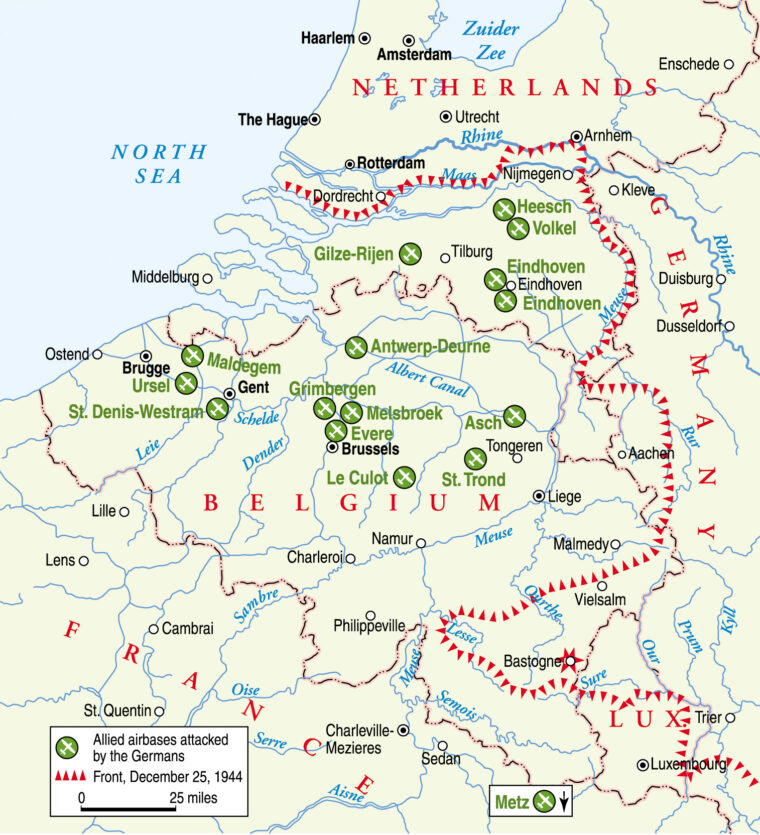
Conditions at Asch (Y-29) were more primitive for the Americans of the 352nd and the 366th. The 366th pilots hopped in their jeeps and staff cars for the bistros in Brussels, but Meyer warned his 352nd that they might have early takeoffs tomorrow. However, his request for a dawn patrol had been denied.
Just north of Asch, at Ophoven (Y-32), 125 Spitfire Wing was also partying hard. Wing Cmdr. Frank Scott-Malden, a Battle of Britain veteran, commanded the wing’s 120 reconnaissance Spitfires, which comprised four squadrons. One of them, the 350th, was Belgian. They had drawn the short straw for the first mission in the morning.
The 2nd TAF’s most northerly airfield was Heesch (B-88), in The Netherlands, where 126 RCAF Spitfire Wing was based in an old Hitler Youth camp. It was better than tents, but still a mass of mud covered with wire mesh. FO Al Bathurst lent his Spitfire to his pal, Flight Lt. Donald “Chunky” Gordon for the morning, as Gordon’s was unserviceable.
At Woensdrecht (B-79) in The Netherlands, the five squadrons of 132 Wing also partied. The Dutch 322nd Squadron’s planes and pilots had not arrived, but the two Norwegian squadrons, 331 and 332, joined the British 66th and 127th to celebrate the New Year. They were set for a 9 am escort mission to Dasburg. At Antwerp-Duerne (B-70), 146 Wing was set for an early morning Army support mission. Wing Cmdr. Denys Gillam, another Battle of Britain veteran, told his men to be ready.
The only base outside Belgium scheduled for attack was also the only tactical airfield in France, Metz-Frasctacy, home to Colonel Ray Steckers’ U.S. 365th Fighter Group (Y-34) and its P-47s. The “Hell Hawks” had just moved there from Mons in Belgium and were celebrating the move in typical fighter jock fashion.
While the Allied pilots celebrated or slept, Bodenplatte began. Just before midnight, four Arado 234 jet bombers of KG (j) 51 flew across the Dutch-German border. Their job was to do a final check of weather conditions, but the jets carried a few bombs anyway. Three planes dropped their bombs on Brussels and its train station, the fourth on Liege. Little damage was done, but it was the first night jet bomber attack in history.
Meanwhile, the Germans prepared their planes and briefed their crews. JG 77’s Major Erich Leie commanded a fighter wing with a great history, but now full of inexperienced pilots, barely able to fly in formation. He told his men that the morning’s raid on Antwerp-Deurne (Y-70) would enable the young pilots to add to the wing’s glorious traditions.
JG 54’s 3rd Gruppe hit the sack early. Their co-tenants at Furstenau, JG 26, did not, holding their New Year’s Eve party anyway. Lieutenant Gunther Bloemertz and his buddies drank and danced with local girls while an orchestra played approved jazz. But shortly before dawn, the Commander broke up the party, telling them, “Take-off in 50 minutes!” The pilots dumped the girls with speed and took their cars to the flight line, where their 60 FW-190s stood lined up.
JG 54’s 3rd Gruppe commander, Major Karl Borris, told his pilots this mission was a major effort. They were to follow the Ju-88 night-fighter on the tarmac and watch for its Goldregen (“Golden Rain”) flares to mark the front lines. On return, they were just fly due east.
Oberleutenant Willi Heilmann of JG 54, also at Furstenau, got his wake-up call at 3 am and joined JG 26 in the big briefing, held in a converted convent and girls school. Their target was Brussels-Grimbergen (B-60). After that, the pilots headed for breakfast in their mess halls. Heilmann ate cutlets, and roast beef and drank a glass of wine. At all JG 2 airfields, pilots got magnificent breakfasts.
Gefreiter (Corporal) Werner Molge of JG 26 rode the squadron bus to the airfield. On the bus, the “weather frog” briefed the airmen. Molge and his pals only got their target briefing at the airfield—“Low level attack on the airfield at Evere”—but were serenaded by his Gruppe’s three-piece band. On the flight lines, ground crews—“black men” in the Luftwaffe—loaded 65-gallon drop tanks on the bottoms of the FW-190s.
Shortly before takeoff, other German commanders got the word. Chiefs of bases not involved in the strike were told to be ready to receive large numbers of returning planes. The 16th Flak Division, whose guns protected western Germany, was finally given the attack plan and routes at 3 am. However, the division’s headquarters did not have time to alert all 50 batteries under its control that a huge number of German planes would be flying west at dawn. When Bodenplatte’s planes came over their heads, the gun crews assumed they were British planes returning late from a raid on the Fatherland.
Early morning fog delayed the takeoffs until just after sunrise. Black men strapped pilots into their fighters. When the rising sun illuminated the snow and airfields across western Germany, engines sputtered to life, pilots closed their cockpit canopies, and 1,035 German aircraft from 11 JGs with 34 groups between them roared down runways and into the air, headed west.
Meanwhile, 2nd TAF was also waking up ready for another day and a new year of combat missions. Squadron Leader K.F. “Jimmy” Thiele led eight Tempests of 122 Wing into the air at Volkel (B-80). At St. Denis-Westram (B-61), Group Captain Alexander Gabsewicz’s 131 Polish Wing was flying at dawn. After its morning strikes, it was to move to its new base.
The same cycle of early morning missions was going on at Eindhoven, Volkel, Heesch, and the other bases. Flight Lt. A.D. Mercer of 268 Squadron at Gilze-Reijen (B-77), flying reconnaissance P-51 Mustangs, drank tea in the old German officers’ mess before flying the first mission of the day. Squadron Leader L.H. Lambert of 168 Squadron got a 4 am-wake up call for a Typhoon-armed reconnaissance strike. He and his pilots lived in a convent outside of Eindhoven shared with its nuns. At Antwerp-Deurne (B-70), Flight Lt. S.J. Eaton of 257 Squadron, another Typhoon outfit, stood around waiting with his pals while the ground crew broke up ice on the runway.
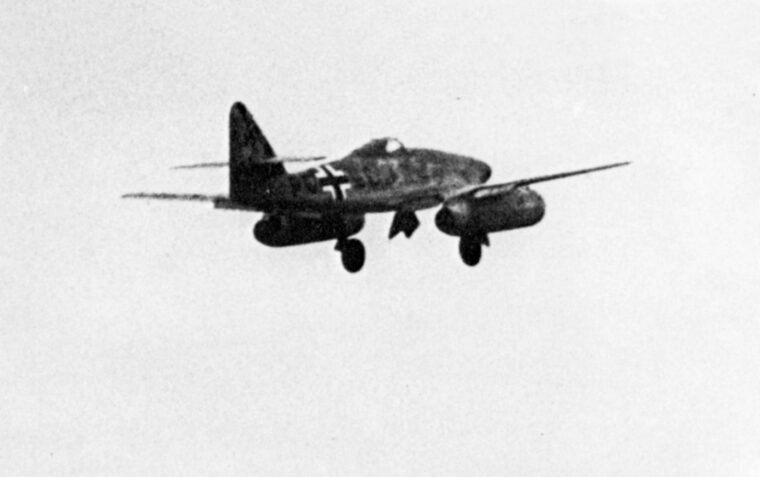
The Melsbroek-based 139 Medium Bomber Wing of B-25 Mitchells roared into the air to hit the road net around Dasburg. Wing Cmdr. Mike Shaw put on his flying suit to test the repaired Short Stirling bomber.
Another early riser was Broadhurst himself, at his headquarters in the Philips Building in Eindhoven, right by the airfield and his personal Fieseler Storch, which had been captured from the Germans. The Storch was kept on the first fairway of the golf course near his office. Normally, Broadhurst was in the air in his Storch at dawn, checking on one squadron or another. This morning, however, he was sipping tea in his office and going over the weather and the day’s operations.
All across northwest Germany, gaggles of Me-109s and FW-190s were lifting off runways, streaking into the sky, maneuvering into formation. Not without troubles, however. The III/JG 6 lost one Me-109 just after takeoff when it suddenly lost speed and smashed into the trees. Oberfeldwebel (Sergeant) Walter Jung’s Me-109’s engine caught fire soon after takeoff. Led by Oberstleutnant (Lt. Col.) Johann Kogler, JG 6 assembled its 70 Me-109s over Quackenbruck and flew behind Hauptmann (Captain) Karl Bibsiem’s lead Ju-88. Their target was Volkel, but Bibsiem got his directions wrong. Instead, he led them to Heesch. Only nine of JG 6’s Me-109s found Volkel.
JG 3, under Oberstleutnant Heinz Bar, a 200-victory ace, was assigned the prize, Eindhoven Airfield, with its two Typhoon wings and Spitfire wing. JG 3 formed up over Lippstadt and flew across the Rhine behind its Ju-88. As the planes roared over the snow-covered plain of Brahast, some of the German aircraft got lost and found themselves heading for Gilze-Rijen.
At Eindhoven, 429 RCAF Squadron was taking off to do weather checks over the Ardennes followed by 168 Squadron and its Typhoons, ready to provide rocket support for the 101st Airborne Division. Following that, 430 Squadron’s Spitfire 14s and 438 and 440 Squadrons’ Typhoons began taxiing out for takeoff, struggling past frozen ridges and bomb craters.
Watching the deployment was FO Gordon Hill of 416 Squadron from Brussels-Evere, whose shot-up Spitfire was fully repaired. All he needed was a starter cart. A combination of frost and rain had left the Evere runway frozen and dangerous for takeoffs and landings. Crewmen were spreading grit on the slippery tarmac.
JG 4, under Major Gerhard Michalski, was also airborne, 55 Me-109s and FW-190s streaking for Brussels behind Feldwebel Gunther Kotschote’s Ju-88 leader. Half an hour from the target, the sun cut through the morning mist, revealing the FW-190s to British and American antiaircraft gunners. They opened fire immediately, bagging Kotschote’s Ju-88 right away. Michalski took over and lost his bearings. He flew in circles 10 miles north of Brussels, and his three gruppen got separated. With flak cutting down JG 4’s fighters, the survivors latched onto passing formations. Most of Gruppe II/JG 4 headed for St. Trond-Brustem, which they thought was their target, Le Culot. Actually, St. Trond-Brustem was 10 miles from Le Culot, but it was full of P-47s. As II/JG 4 swooped in, they saw JG 2 attacking as well.
At 8:05 am, the Allies got their first word of the attack when an Auster pilot, flying an artillery-spotting mission, shouted into his radio, “Have just passed formation of at least 200 Messerschmitts flying low on course 320.”
The Richthofen Geschwader, led by Oberstleutnant Kurt Buhlingen, had the new FW-190 Ds in the I and III Gruppen. The II Gruppe still flew Me-109s. Told to unite over Coblenz, JG 2 was to fly south over the Schnee Eifel and then head northwest for St. Trond. They had trouble, too. Unteroffizier (Sergeant) Fritz Altpeter’s FW-190 crashed near Diersdorf, killing him. Heavy American flak shot down four planes over Aachen, including Gruppe III/JG 4’s skipper, Oberstleutnant Alfred Druschel. As JG 2 flew over the Schnee Eifel, American guns blasted 13 more planes out of the sky.
At 8:14, JG 26’s planes took off, their spirits raised by a three-piece band at Nordhorn. Pips Priller took off in the lead accompanied by his longtime wingman, Unteroffizier Heinz Wodarczyk. The two had been the only Luftwaffe pilots to attack the D-day beaches and had miraculously survived their strafing run. JG 26 was to attack in two forces, I/JG 26 and III/JG 54 in one punch under Pips Priller, aimed at Brussels-Grimbergen, while Gruppen II and III of JG 26 hit Evere.
But as the I/JG 26 and III/JG 54 German planes flew over the German-occupied Netherlands, they came under fire from trigger-happy Luftwaffe flak emplacements protecting V-2 launching sites around Rotterdam. They shot down four of their own planes. However, Canadian antiaircraft gunners proved more accurate than their Luftwaffe counterparts. The Canadians shot down four planes, sending two of them spiraling into the North Sea.
Meanwhile, JG 26 flew on. As they crossed the Belgian border, they were hit by 308 Polish Squadron based at St. Denis-Westram. The Poles shot down five Germans without losses. Flight Lt. Zbigniew Zimgrodski shot up 1/JG 26’s Obergefreiter Dieter Kraegerloh’s FW-190. Kraegerloh was too low to bail out, and his flaps were shot up. Unable to cut speed, he was flung into the dashboard when the plane crashed, breaking his back. Unable to move, he waited until British troops cut him out of the wreckage.
At 9:20, I/JG 26 and III/JG 54 finally hit Grimbergen only to find the airfield was empty except for four B-17s and a P-51. Priller was furious. Intelligence assured him Grimbergen was a major base. Disgusted, he ordered Major Karl Borris, head of I/JG 26, to strafe the base while he headed back to Furstenau to yell at the intelligence officers.
Down below, Group Captain Alexander Gabsewicz and his adjutant were about to drive from their billets to breakfast and start flying in 131 Polish Squadron.
Meanwhile, II/JG 26 and III/JG 26 swooped in on Evere at 9:20 am and were amazed to see Spitfires lined up on one side of the flight line, multi-engine planes on the other side, with more fighters ready to attack. The III/JG 26’s boss, Hauptmann Walter “Count” Krupinski, couldn’t lead his own attack—his engine was sputtering from a flak hit. Irritated, he turned over the attack to Major Anton Hackl, who led II/JG 26.
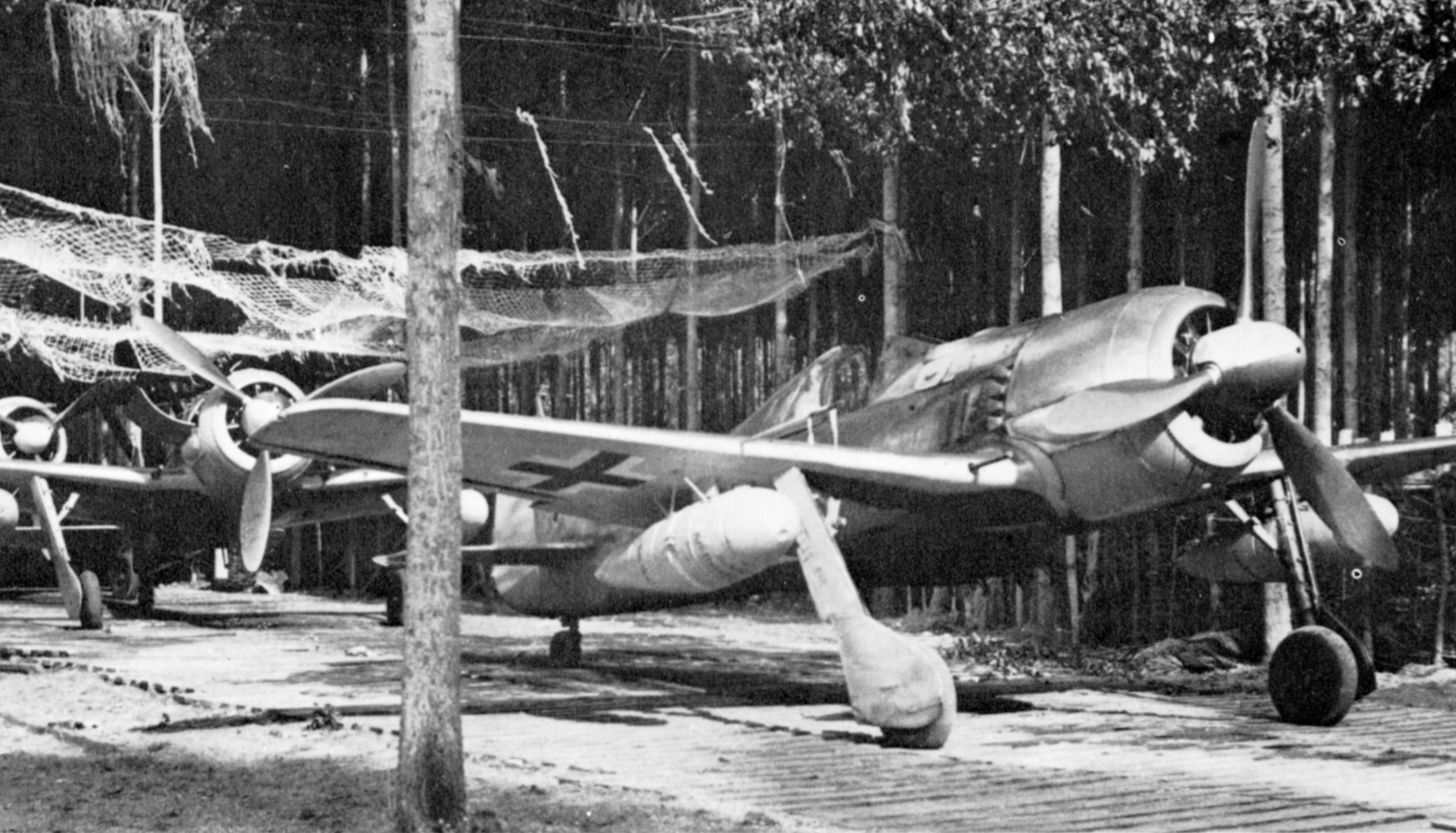
Down on the deck, FO Ken Langmuir and some other pilots not on for missions, worked off their massive hangovers by tossing a baseball around and shooting the breeze. The 416 Squadron’s 12 Spitfire 16s were readying for takeoff. Wing Cmdr. Johnnie Johnson paid little attention to the sound of incoming aircraft—he thought it was just another American formation.
JG 11, under Oberstleutnant Gunther Specht, had clearly marked maps, orders to maintain strict radio silence, and ceilings of 150 feet to avoid Allied radar. Following Ju-88 pathfinders, they were delayed half an hour by mist. The delay resulted in their getting a dose of German flak before hitting Allied lines. The German guns did no damage, but British flak hit Oberstleutnant (1st Lt.) Adolf Fielder in the head. Amazingly, he was able to make a forced landing in a field where he was captured. The rest of the planes spotted their target, Asch, by 9:35 am, and 70 FW-190s and Me-109s raced in at treetop level.
On the ground, Colonel John C. Meyer of the 352nd Fighter Group, denied permission to fly a dawn patrol, attacked his powdered eggs and coffee. While he ate, he got word from the Ninth Air Force that the group could put up a 12-plane preventive patrol as long as it would not wreck the day’s planned escort mission for the Mighty Eighth Air Force. Delighted, Meyer prepared his patrol. With his wingman, Lieutenant Alex Sears, he took off heading east at 9:40 am
Hauptmann Karl Hrdlicka gave simple orders to the men of his 1/JG 2 at 6 am—take off at 8 am, hook up with II/JG 2 and III/JG 2 over Koblenz, and then hit St. Trond-Brustem, where American fighters were reportedly parked wingtip to wingtip. I/2 and III/2 flew FW-190s so fresh from the factories that there had been no time to paint squadron markings on them. II/JG 2 flew Me-109s. III/JG 4, under Oberstleutnant Alfred Druschel, who had just taken over the gruppe that morning, would join them in the attack.
Trouble began over the Westerwald. Unteroffizier Fritz Altpeter’s FW-190 started spewing black smoke. Altpeter crashed and died. Feldwebel Karl Tschelesnig was luckier. When his undercarriage would not retract, he turned for home and got his plane repaired. But when he flew off to catch up with his buddies, flak tore up his plane as it zoomed in at treetop height. Tschelesnig pulled his plane up to 600 feet and bailed out.
American flak nailed Druschel, too, killing the 800-mission veteran. Major Gunther Dornbrack took over in midflight. But more American guns opened up, shooting down Unteroffizier Otto Dost, Unteroffizier Friederich Opteenhostert, Oberfeldwebel Fritz Schuler, and 13 pilots in all. Luck determined who survived. Unteroffizier Helmut Breitweg crash-landed and was captured, but Unteroffizier Ernst Klein crashed and was killed nearby.
At 8:45, JG 2 approached its St. Trond-Brustem (A-92) target, home of the U.S. 48th and 404th Fighter Groups. The 48th’s war diary noted, “At 8:45, when some of the Group had taken their hangovers to work and most had kept them in bed, an amazing thing happened. An unfamiliar drone of engines was heard …”
When Hauptmann Hans-Georg Hackbath briefed his I/JG 1 pilots at Twenthe, they were relieved to hear that most of their approach would be over German-held areas, and they would be joined by Haputmann Harald Moldenhauer’s II/JG 1 and his 55 Me-109s. Their target was Maldegem Airfield (B-65), which intelligence said was home to 485 Royal New Zealand Air Force Squadron and heaps of Spitfires. The target would require five passes. II/JG 1, leaving its base at Drope, was to hurl its 30 FW0-190s at St. Denis-Westram (B-61) near Ghent, home of 131 Polish Wing.
As I/JG 1 flew over Rotterdam and the Dutch coast, German Navy antiaircraft gunners mistook them for the RAF Spitfires that harassed them every day and opened fire. German guns shot down and killed Unteroffizier Heinz Jurgan, an 80-mission veteran of North Africa and Italy and an artist by trade. Unteroffizier Heinz Bohmer failed to keep his plane aloft, crashing helplessly and fatally into the ground near Dordrecht. Also falling to German guns was the Geschwader commander, Herbert Ihlefeld, hit by flak near The Hague. He managed to land without injury in a farm field.
Meanwhile, at 9 am, I/JG 1’s 4th Staffel (Squadron), under Oberleutenant Hans-Gottfried Meinhof, swooped down on its secondary target, Ursel Airfield (B-67), listed by intelligence as a base for 12 Spitfires.
The intelligence was wrong. The Ursel Spitfires had been flown to England. All that the 424th RAF Rearmament and Refeuling Unit had on hand was a Mosquito, two B-17s, and two Avro Lancaster heavy bombers, all under repair. The Mosquito was badly damaged, the rest all heavily damaged by German flak. Leading Aircraftsman Edward Green was on his way to pick up a working party in a van when he remembered he also had to check another truck for fuel and mileage. While he read the numbers off, he heard incoming aircraft. He figured it was a squadron of Spitfires due in from England.
At St. Denis-Westram (B-61), 131 Polish Wing took off in its Spitfire 9 fighters to attack enemy targets and fly armed reconnaissance. After the Spitfires flew off on their missions, 30 Spitfires and a B-17 were still left on the ground. The Flying Fortress was another shot-up plane being repaired by an American maintenance crew. It was a massive task. While the Americans struggled with technology, the Poles jammed their base church for Sunday Mass.
The JG 77 “Red Hearts” had fought a tough war—Denmark, Norway, Normandy. Major Erich Leie had just taken over the JG when Major Johannes Wiese was shot down and wounded on December 29. Fortunately, Leie was no slouch with more than 100 kills.
Now JG 77 was to hit Antwerp-Deurne (B-70), home to 115 and 146 RAF Fighter Wings, a 100-mile trip. Leie chose to swoop around Rotterdam and hit the base from the north, doubling the distance but also the chance of surprise. More than a hundred Me-109s roared across clear skies and took German Naval antiaircraft fire. German guns shot down Lieutenant Heinz Abendroth, and he landed safely behind Allied lines. Unteroffizier Johann Twietmeyer, also hit by German flak, fell to earth and was captured. British guns were effective, too. The commander of II/JG 77, Lieutenant Heinrich Hackler, tried to evade British guns and slammed into barrage balloon cables, which tore off his Me-109’s right wing and killed him.
A few minutes later, I/JG 77 spotted Woensdrecht Airfield (B-79), mistaking it for Antwerp-Deurne (B-70). I/JG 77 swooped down on the wrong target, while the other gruppen pressed on and found the right one.
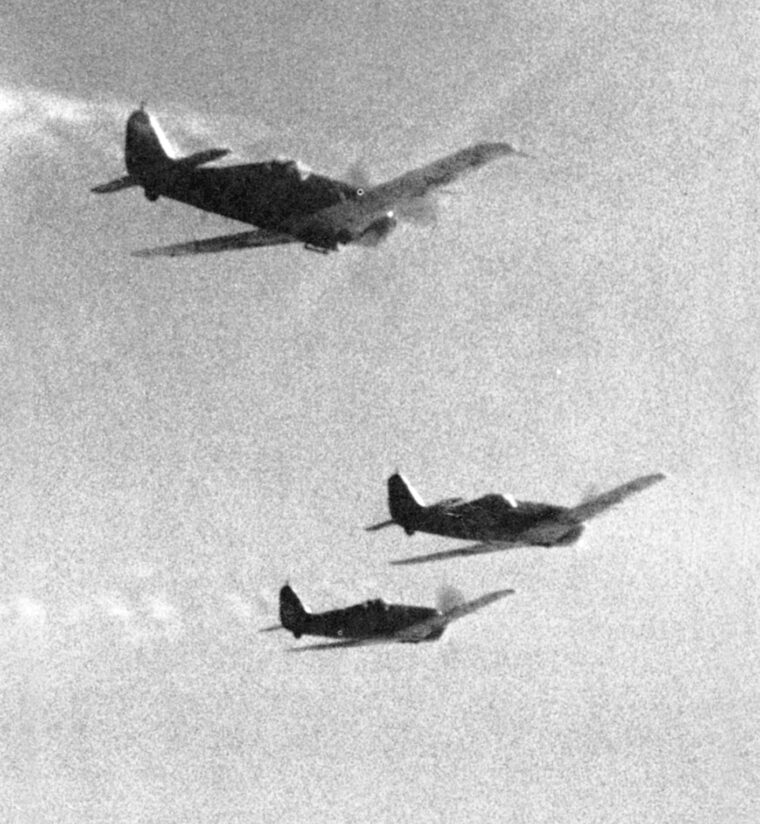
Woensdrecht was home to five Spitfire squadrons, but only two were there at the time, 331 and 332 Norwegian. Antwerp-Deurne housed two wings—145 and its four Spitfire squadrons, and 149 and its five Typhoon squadrons. The whole base had been shut down by an overnight snowfall, and all hands were digging snow and ice off the runways.
I/JG 27 and IV/JG 54 drew Brussels-Melbroek (B-58), and Major Ludwig Franzisket’s FW-190s followed their Ju-88 guides over Utrecht, where German flak shot down three planes. When the JG closed in, III/JG 27 peeled off to hit Gilze-Reijen (B-77).
Brussels-Melbroek (B-58) was having a busy morning. The 139 Bomber Wing’s 35 B-25 Mitchell bombers were on their way to attack the Dusburg road center, while the pilots of 16 Photographic Reconnaissance Unit were waiting for the ground crews to finish de-icing their runway so they could take off. While everyone waited, Flight Lt. Hugh Tudor and FO Ian Ewing of 140 Mosquito Squadron were sitting in a jeep, getting ready to fly a Mosquito to England, enjoying the clear skies. Squadron Leader Mike Shaw was recovering from his hangover and preparing to test fly that Stirling.
Oberstleutnant Helmut Bennemann had 100 victories and command of JG-53, which had excellent photographs of its target, Metz-Frescaty (Y-34). Bennemann’s 70 Me-109s in three gruppen were to hit the base in three low-level passes. The plan began to disintegrate when III/JG 53 flew into a patrol of American P-47s. The Germans had to jettison their drop tanks when the Americans attacked, forcing them to return to Kirrlach. Short of 20 planes, Bennemann’s pilots flew on anyway.
At Metz-Frescaty (Y-34), 11 P-47s of the 387th Fighter Squadron took off at 8:28 am, on an armed reconnaissance. They pounded a German train, blasting five freight cars, then headed home, landing by 9:13. When they were done, the 388th took off, while the 386th prepared for its morning strike. Only one pilot stood guard in his “alert” P-47, Captain Tom Stanton of the 386th. His wingman, Lieutenant Samuel Lutz, was warming himself over a gasoline fire before climbing into his P-47.
Flight Lieutenants Jim Young and Ed Packwood of 2 Squadron took off from Gilze-Reijen (B-77) at 8:29 on a tactical reconnaissance mission, and 15 minutes later spotted the incoming German strike—two Ju-88s and more than 30 FW-190s and Me-109s headed west on the deck. Young and Packwood pulled up into the sun in their Spitfires and dived down into the rear of the German formation. Packwood opened fire and tore apart an Me-109. Young flipped open his radio microphone and told his controllers back at Gilze-Reijen that bandits were incoming.
His was not the only tocsin sounded. Radar operator Ron Staughton was manning a station at Boortmeerbeek in Belgium when he reported “150 plus bogies headed south west.” He corrected that to “250 plus—range eight miles.”
His controller was not impressed. “You’ve probably got a spurious echo.”
“I’ve been doing this job for a long time,” Staughton answered, and summoned his commanding officer, Flight Lt. Owen Halfhid. He confirmed the sighting and reported it to the controller. Again came the answer, “Spurious echo.”
By now Halfhid could hear the German planes heading over him. “If you don’t believe me, go outside and see for yourself!”
It was too late. All across Belgium and the Netherlands, Bodenplatte was going in with thunderclap surprise.
As the lost gruppen of JG 6 swung in on Heesch, Flight Lt. John Edison, in the control tower, thought the incoming planes were American P-51s. Gunner Garry Whitmore thought they were American P-47s. When the base’s defending 40mm Bofors antiaircraft guns opened fire, everybody leaped out of their bunks and beds.
At all the airfields, it was the same thing. Wing Cmdr. Kit North-Lewis of 124 Wing was glancing out the window when he saw the string of 12 incoming Me-109s and wondered “what the hell they were doing in Eindhoven.” FO Ken Langmuir at Brussels-Evere thought it was a disorganized group of American P-51s.
At Eindhoven, 25 German fighters swooped down into neat strafing runs led by an Me-262. Desmond Shepherd, a 137 Squadron armorer, saw two FW-190s collide with each other head-on. Flight Lt. Ed MacKay, in his pajamas, heard the noise from the convent where he was billeted and ran to the window, seeing Me-109s and FW-190s zooming over the rooftops.
On the strip, Flight Lt. “Gibby” Gibbons was taking off in his 168 Squadron Typhoon when JG 3’s Me-109s and FW-190s charged in. Feldwebel Gerhard Leipholz had a perfect tail shot of Gibbons as he took off, but Gibbons went into a steep turn that put him behind Leipholz. A single burst of fire, and Leipholz was dead. Another FW-190 shot up Gibbons’ Typhoon, killing him.
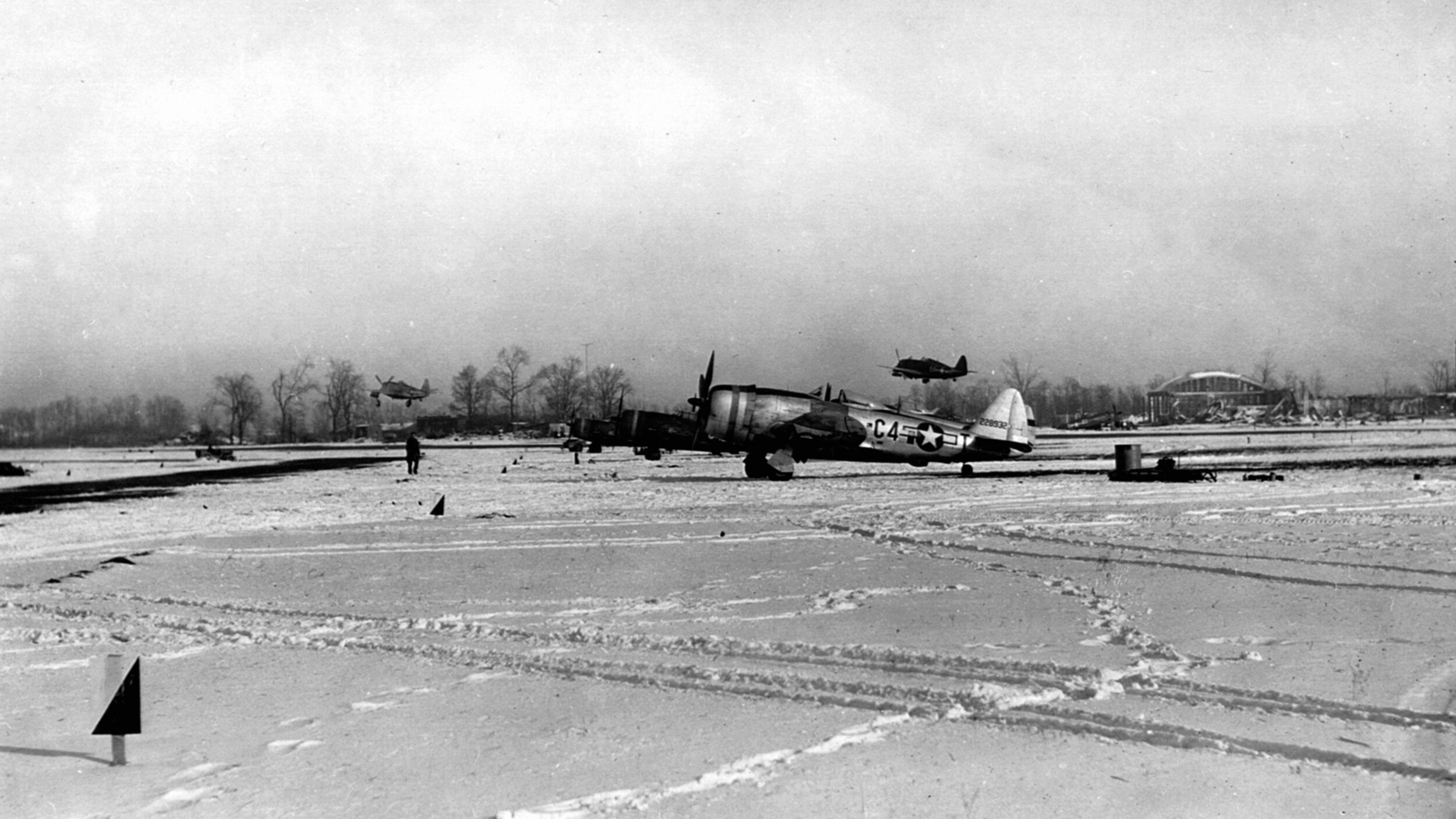
Flying Officer Len Wilson of 442 “Caribou” Squadron was flying an armed reconnaissance when the Heesch controller ordered his section home. At 10,000 feet, Wilson swung Spitfire Y2-F back home and saw enemy aircraft on the deck at right angles. He gave a “Tally-ho” call, and with his wingman, Flight Lt. D.M. “Tex” Pieri, Wilson swooped down to attack. Wilson was amazed to find more than 20 enemy planes. At nearly point-blank range, he got off a burst and found himself facing an entire squadron of FW-190s. Wilson had the advantage of speed and maneuverability and broke around to port. An FW-190 followed Wilson, and Pieri followed the German plane, shooting it down. Wilson’s plane was damaged, and it took everything he had to keep the rudder under control and break away from the battle. He did manage to land his damaged plane.
Major Anton Hackl’s JG 26 planes caught four Spitfires taking off at Brussels-Evere and blasted three of them. Warrant Officer (WO) Lou Jean and FO Len Commerford jumped out of their planes and hid behind metal drums, where Jean discovered he had taken a splinter in a leg. Only section leader Flight Lt. Dave Harling got airborne. Hackl’s planes split their targets—half hitting the Spitfires on the ground, the other half attacking the antiaircraft guns.
Johnnie Johnson was stunned to see Me-109s swooping down from the west, blazing away at a section ready for takeoff, led by 416’s Squadron Leader Dave Harling. Eleven Spitfires trailed Harling on the runway. The German gunfire tore up three planes behind Harling, but he took off, throttle wide open. He soon had a German in his sights. But Unteroffizier Heinz Gehrke of III/JG 26 had a bead on Harling and sneaked in behind the Spitfire, shredding it with cannon fire. Harling’s plane crashed into a house, killing him, but not the occupants.
Oberleutenant Wilhelm Hofmann’s squadron hit the airfield with discipline. Gefreiter Werner Molge chewed up the Canadian flak, making four passes over the base through increasingly thick smoke before heading home alone. Unteroffizier Norbert Risky was less lucky. He took a flak hit and crash-landed behind his own lines.
At Brussels-Grimbergen, Gabsewicz and his adjutant watched the incoming planes, assuming they were an early morning patrol. But Gabsewicz’s adjutant shouted, “They’re bloody Focke-Wulfs.” Gabsewicz leaped away from his coffee and marshaled the base’s airmen to man the antiaircraft guns.
Major Karl Borris’s I/JG 26 swooped down on the base, quickly wrecking the four B-17s, a P-51, and a Mosquito. But Gabsewicz’s men shot down JG 54 Feldwebel Gunther Egli, making him crash right on the field. Egli survived, as did pilot Hans-Joachim Werner, who bailed out.
The Brussels-Grimbergen raid was a pointless flop. The Luftwaffe wrecked one B-17 and one P-51, two hangars, 12 trucks, and two fuel tankers and killed one man. I/JG 26 lost 12 planes. III/JG 54 did even worse, losing 10 of 17 FW-190s. Leutnant Theo Nibel had to make a belly landing when his FW-190’s engine quit, but the cause was not Canadian gunfire. A partridge had slammed into his radiator.
While Nibel survived to tell his tale, other Luftwaffe pilots died. Among the German pilots killed was Heinz Wodarczyk, Pips Priller’s faithful wingman.
Lieutenant Colonel Meyer was just taking off from Asch when he saw flak bursts all around him and Gefreiter Gerhardt Bohm’s FW-190 from JG 11 flying right at him. Bohm was intent on shooting up five parked C-47 transports, but Meyer hit the firing button first. His 23rd kill was his first while taking off.
When JG 2 hit the American base at St. Trond-Brustem, the pilots got a warm reception from the antiaircraft gunner protecting the 48th and 404th Fighter Groups’ P-47s. Fuming muzzles brought down 10 German aircraft. Unteroffizieren (Sergeants) Adolf Redlich and Helmet Bollwerk were both killed. Leutnant Werner Edelhoff bailed out and landed in a field facing angry American airmen brandishing M-1 carbines.
Less than a dozen P-47s fell to German strafing at St. Trond-Brustem, but the Luftwaffe lost 15 JG 2 aircraft flying to the base. In the battle, JG 2 lost 21 more pilots, killed, missing, or captured. JG 4, which had gotten lost and stumbled across the field, made one pass and lost only Wegner’s plane in the action, but four pilots overall.
The attack on Woensdrecht was also a failure. The pilots of I/JG 77 thought the airfield was Antwerp-Deurne, swooped in, and found the airfield fogged in. They headed back to Dortmund without firing a shot.
The real Antwerp-Deurne got a visit from 12 Me-109s of III/JG 77. They stormed in at 150 feet over the Scheldt Canal, greeted only by ground flak. With the airfield still iced over, the planes could not take off. Flight Lt. Stan Eaton of 257 Typhoon Squadron watched the disorganized groups of Me-109s swoop down in gaggles.
The Antwerp-Deurne gunners fired off 1,270 rounds of ammunition at 30 Me-109s. The Germans lost six pilots killed, four missing, and four captured. Damage to the British was slight—three Typhoons destroyed, several damaged, along with a B-17 and C-47 damaged.
At the RAF maintenance depot at Maldegem, I/JG and III/JG 1 had better luck. Seventeen freshly repaired Spitfires were lined up in a row, guarded only by two stationary 20mm guns and two Vickers machine guns. Ihlefeld’s fighters swooped down and set 11 of the Spitfires on fire in a matter of minutes and damaged two more. Three Me-109s were shot down.
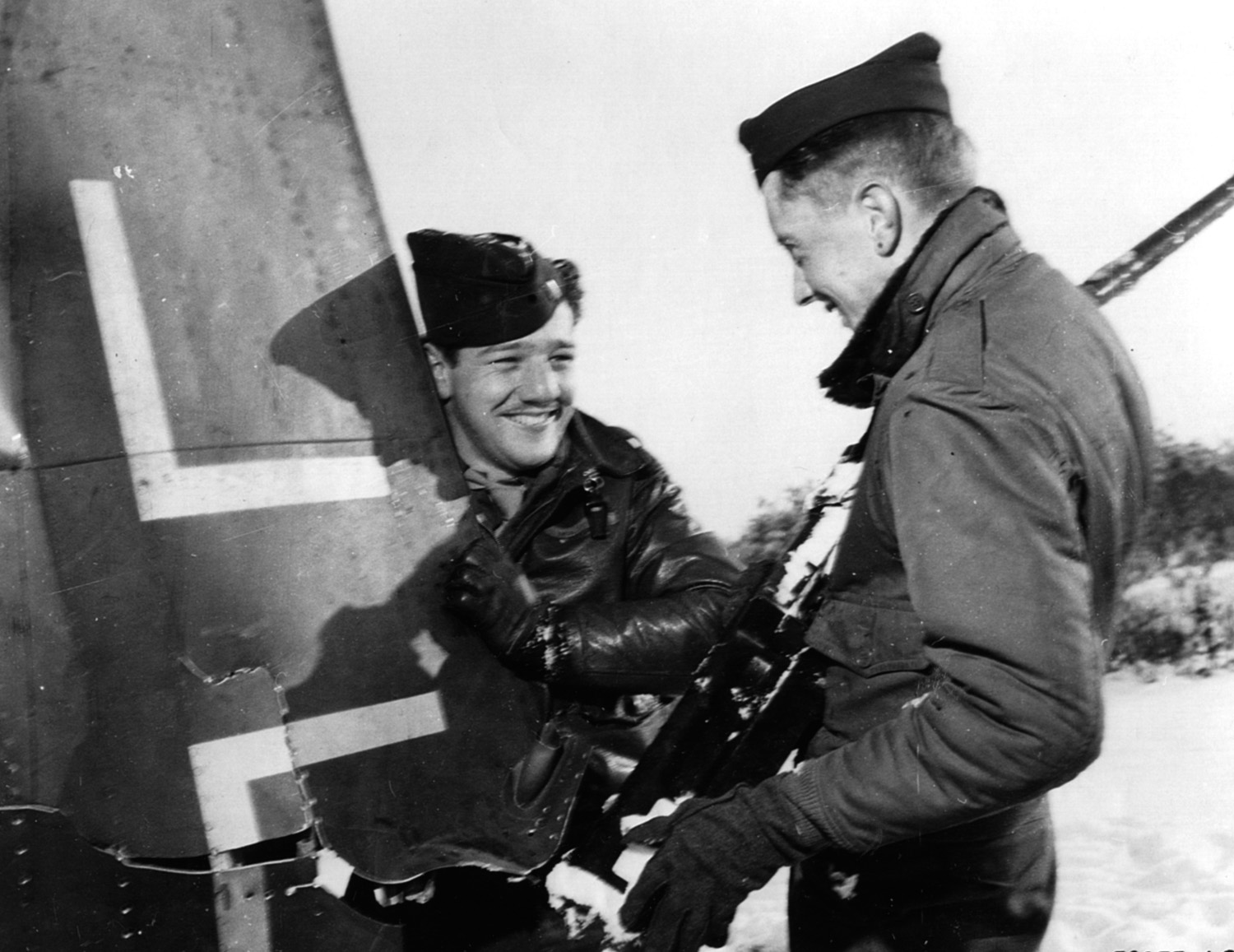
At nearby Bruges, Flight Lt. Bob Fowler and his pals woke up in the Cornet D’Or Hotel and saw “the best close-up view of a German fighter flown by a German pilot” he had in the whole war. Fowler and FO Norm Powell hopped in a truck to head for Maldegem and their Ansons.
Another maintenance shop, at Ursel, faced three FW-190s of I/JG 1. The Germans thought the 424 RAF Rearming and Refueling Unit was a brand-new squadron of Spitfires. When they swooped in, a corporal asked Sergeant Peter Crowest for permission to fire his sten gun at the Germans. “Stay under cover, you stupid bastard!” Crowest retorted.
The swooping Germans were stunned to find no Spitfires parked on the strip, but they blasted open the damaged Mosquito that Ed Green was supposed to check on. Had Green not stopped to check his truck’s mileage before working on the battered plane, he would have gone up in the fireball.
Next, the fighters stitched up the American B-17 being repaired along with two Lancaster bombers. The Americans busy repairing the B-17 were actually relieved. Their job was finally over. Of the four German planes sent to attack Ursel, two survived.
At St. Denis-Westram, 302 Polish Squadron was just landing, tanks nearly dry, from its morning strike when II/JG 1 swooped in. Flak gunners opened fire and brought down a Spitfire. The FW-190s of II/JG 1 stitched up nine more planes parked on the ground, but missed the rest of the landing planes.
The 308 Squadron was in the circuit when II/JG 1 arrived. Flight Lt. Walclaw Chojnacki’s first thought was to jettison his hung-up bomb, but the tower ordered him to return to base. Chojnacki flew back and lowered his wheels just as three FW-190s appeared in front of him. Chojnacki hit the retract button on his landing gear and the firing button on his control stick, blasting off the tail of the rear FW-190 from 800 yards away. Meanwhile, three more FW-190s jumped Chojnacki and ripped his plane apart. Chojnacki’s plane plunged into the ground and exploded, killing him.
Other Poles tore into the Germans with their usual tenacity. Even though he was short on fuel, Flight Sergeant Josef Stanowski confronted the planes attacking St. Denis Westram and shot down an FW-190 right away. He saw another one and attacked. Amazingly, the German pilot, probably poorly trained and hitting the wrong button, lowered his wheels. Stanowski took advantage of his enemy’s slower speed and confusion to fire another burst. The FW-190 hurtled into the town center and exploded.
The 317 Polish Squadron arrived at St. Denis-Westram to find its base blazing and the 308 Squadron engaged. The 317 Squadron Leader, Marian Chelmecki, led his men into attack and saw an FW-190 get on Lieutenant Czeslaw Mroczyk’s tail. Chelmecki pulled between the FW-190 and Mroczyk, forcing the German off. Chelmecki climbed into the sun, saw another FW-190, and fired on it at 400 yards. The FW-190 smashed into a small building in flames, right in front of 302 Squadron’s intelligence officer, Flight Lt. Jan Bendix.
All across The Netherlands and Belgium the air battle continued to rage. Nine FW-190s, one Me-109, and a lone Me-262 managed to find their target at Volkel, making half-hearted passes at 122 Wing’s Tempests lining up for takeoff. FO Bob Adcock and Bill Bailey watched bullets hit the ground around them but miss their aircraft. The Germans perforated a few Tempests but lost six pilots killed or missing, and one prisoner, in the Volkel raid.
By comparison, JG 27’s attack on Brussels-Melsbroek went off beautifully despite heavy flak. On the first pass, Hauptmann Hans-Heinz Dudeck’s IV/JG 27 pilots blasted the Stirling bomber Wing Commander Mike Shaw was scheduled to flight test, much to Shaw’s relief. Also blasted were a 140 Squadron Mosquito and Coningham’s personal transport.
Down below, Flight Lt. Hugh Tudor heard a buddy yell, “Christ! Look at those Hurricanes!” Tudor glanced at the incoming machines and retorted, “Hurricanes be buggered—they’re 109s!”
Tudor and Flight Lt. Ian Ewing ran back into the mess and the officers’ quarters to get everyone out and into the air raid shelters. Six of 10 antiaircraft guns were out of action, but the rest, joined by bren guns, opened up. They had some success. Hauptmann Heinz Dudeck led IV/JG 27 in to attack, and when he pulled out his engine died. From 500 meters up, he bailed out. The parachute caught on the plane’s tail and tore. He landed in a tree and was taken prisoner.
The III/JG 27 and III/JG 3 were just as tough at Gilze-Reijen, catching 35 Reconnaissance Wing’s Typhoons just as the pilots had arrived at the airfield in trucks. RCAF Flight Lt. Bill Baggs jumped straight from his truck and wrecked his new, clean uniform in a puddle of muddy water.
By now, some of the British were beginning to recover from the shock and impact. At Heesch, FO Doug Cameron of 401 Squadron led his pals to attack the oncoming Me-109s. He blasted open the oxygen tank of the tail Me-109 of one gaggle, sending it crashing into a field with a large explosion. Then he gunned down the group’s leader. After checking his “six,” he saw an Me-109 orbiting 1,000 yards away, lost. Cameron swooped in and put bullets into its engine. The Me-109 turned toward home. The German plane lost height and smacked into a field on its belly.
The Heesch defenders did well. Flight Lt. Johnny MacKay shot down one Me-109, then headed for Nijmegen where he saw a Tempest chase an FW-190. The German swung round on the Tempest’s tail, so MacKay jumped behind the FW-190, closing to 30 yards behind the German. The FW-190 pilot panicked, did some flick rolls, and struck his port wing on a frozen lake. MacKay pulled out and headed home. An Me-109 was in his path. MacKay slammed down on the deck, playing a game of chicken with the German, and the German did not blink. He hit some trees and the Me-109 broke apart.
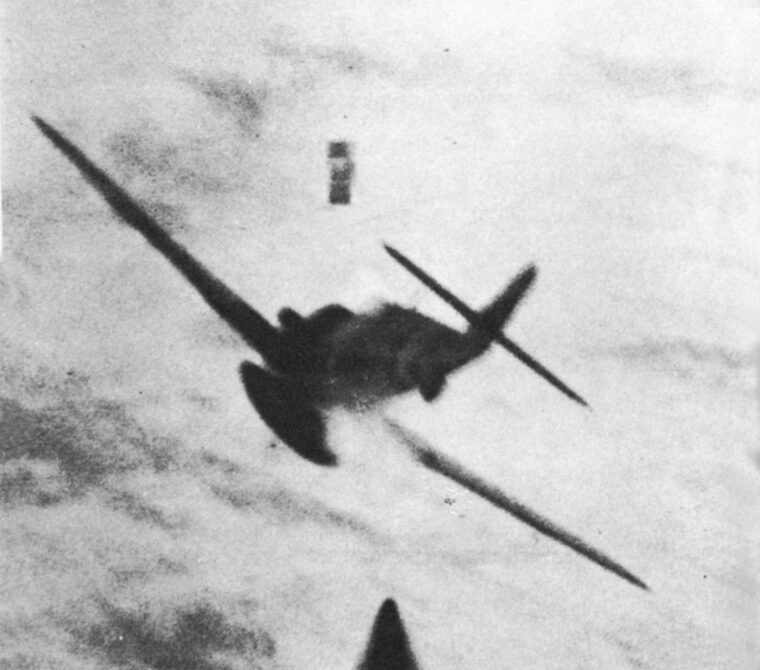
Another Heesch defender, Flight Lt. D.C. “Chunky” Gordon of 442 Squadron, took several shrapnel wounds in his back from friendly fire after shooting down two German planes. He crash-landed outside the airfield and carefully emerged from the plane. Flight Lt. R.C. “Jack” Smith found himself amid 10 enemy planes. He expended his ammo, then flew back to Heesch, running out of gas as he approached and making a perfect dead-stick landing. In all, 126 Wing shot down 24 planes—a new record for one day of air combat.
Other pilots were less lucky. Squadron Leader Pete Wilson, the new boss of 438 Squadron, and his wingman, FO Ron Keller, started taking off in their Typhoons from Eindhoven (B-78) as JG 3’s FW-190s and Me-109s swooped in, guns blazing. A bullet hit Wilson in the stomach. He managed to throttle back, pull his plane off the runway, and climb out of the cockpit before collapsing. Keller, however, was caught by an FW-190 while taking off, and the German’s bullets exploded Keller’s Typhoon.
The rest of 438 Squadron did not even get airborne. PO Don Campbell was in his Typhoon cockpit when German bullets ripped open his plane, rendering it immobile. While Campbell took cover in his cockpit, FO Bill Beatty, in the Typhoon right behind, maneuvered his plane off the runway, jumped out of his cockpit, and into a foxhole, landing on an airman. Two more airmen landed on Beatty.
At 138 Squadron’s dispersal, FO Bob Spooner sent everyone underground, but he and Flight Sgt. Ron Large set up a bren gun and fired at the attackers. An FW-190 came in close. Spooner could see the pilot looking down at them. The bren gun’s bullets started knocking pieces off the plane, and it crashed on the runway.
For 440 Squadron, it was the same thing. Pilots abandoned their planes and hit the dirt. FO Ed Flanagan’s goggles saved his eyes from being cut up by broken glass when a bullet hit his instrument panel’s gauges. He took more bullets in his thighs as he climbed out and managed to walk to safety at the control tower despite the additional burden of his parachute.
Flight Lieutenant Ernie Savard, on the runway when the Germans arrived, spun his Typhoon around so that his armor plating was between him and the German bullets. Meanwhile, he struggled to disconnect his radio and oxygen mask but did not have enough time. In came German planes straight ahead on a strafing run. Savard fired on them, ducking low. The Germans shot past, and Savard finally got out of his plane, running across frozen ground to find protection in an old shell hole, where he also found an airman, hit by a bullet, dying.
Destruction continued to rain down on Eindhoven. Flight Lt. Jim Prendergast of 430 Squadron was in line for takeoff. He glanced back to see if any planes were in the circuit and saw more than 15 yellow-nosed Me-109s zooming in, guns belching fire. Prendergast’s Spitfire was hit. His plane was trapped, so he turned it around and shot back with his cannon. Then, he saw the ground crew that had been guiding him to the takeoff point still sitting on the wings. He waved them off, and all three ran into piles of snow to hide.
Flying Officer Gordon Hill, ready to flight test his newly repaired Spitfire, found his plane had been shot up. FO Phil Macklem, ready to fly back to England after his tour, took an Me-262’s shrapnel in his shoulder, which delayed his return for two days. Squadron Leader Hart Massey, son of future Canadian Governor-General Vincent Massey and nephew of famed actor Raymond Massey, walked out of his trailer to see the action. The 439 Squadron intelligence officer, Massey was understandably amazed. He hit the dirt but still took wounds in his head, chest, and rump.
Airman Ron Norris was hit by cannon fire and died the next day. Flight Sgt. Reginald Bazley took a bullet in the hand. Another NCO ran off to get a first aid box. By the time he got back, Bazley was dead. Airman Desmond Shepherd did not move as bullets whizzed through the grass. Then, an empty German 20mm shell landed on his forage cap.
Overhead, pilot Friedrich Hameister, on his first mission, shot up a fuel tanker and twin-engine plane on the ground and shot down a Spitfire in the air that had just shot down an Me-109. Moments later, another Spitfire shot up Hameister’s Me-109. He miraculously landed the burning plane in a field. After aimlessly wandering around The Netherlands for the rest of the day, he was caught sleeping in a haystack.
At the height of the battle, the phone rang in 127 Wing’s operations trailer at the end of the Brussels-Evere runway. Lieutenant Frank Minton heard a voice shouting, “Large gaggles of Huns near your airfield! Get your Spits off!”
Minton replied, “You’re too late. If I stick this phone outside, you’ll hear their bloody cannons!” Still, the trailer crew stayed at their posts and ordered their airborne sections to return to base at top speed.
At Asch, Lt. Col. Meyer of the U.S. 352nd Group had one kill this day so far. Now he chased an FW-190 to Liege and sent it crashing. Out of ammunition, he streaked for home.
Home was under attack, but the other American pilots were fighting back. Lieutenant Melvin Paisley fired three of his antitank rockets at an Me-109, nailing his target with the third.
At St. Denis-Westram, the 308th Polish Squadron, a highly trained outfit that, like other Polish squadrons, liked the point-blank attack, charged into battle. Flight Sgt. Zygmunt Socyzinski shot down a German plane at 100 yards. Flight Lt. Bronislaw Mach did the same to an FW-190, sending it into the Scheldt River. Short on fuel, Flight Sgt. Josef Stanowski headed back for base, saw Untertoffizier Karl Hahn’s FW-190, and shot it down. Then, again at 100 yards, he shot up II/JG 1’s commander, Hauptmann Hans-Georg Hackbarth. The German plane slammed into the back of a Ghent flower shop, hurling the flier’s dead body into the street. PO Andrezj Dromlewicz topped them all. He shot up an FW-190 at 30 yards, blasting off the plane’s starboard wing.
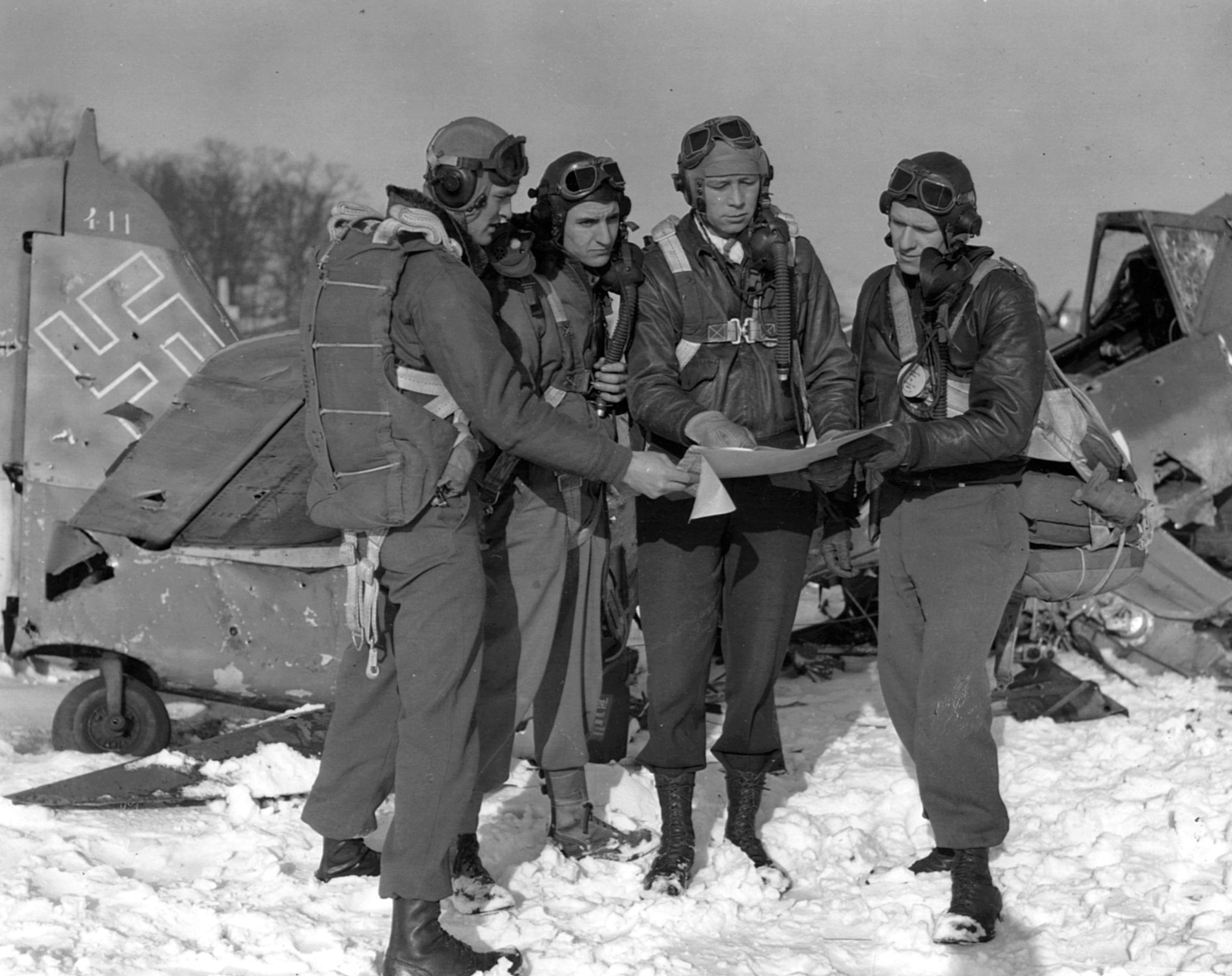
Unteroffizier Fritz Hoffmann also bailed out at the hands of Flight Lt. Czeslaw Mroczyk, the second time Hoffmann had to hit the silk. This time Hoffmann landed amid Dutch civilians and police, who beat him severely.
All across the Western Front, Allied planes returning from morning strikes were vectored in to attack the German planes. Flight Sgt. Maurice Rose of 3 Squadron was flying a Tempest when he picked up a JG 6 Me-109 at 200 yards ahead. He closed to 100 yards before he ran out of ammunition, but the Me-109 would not crash. Rose shouted into his radio for anyone with ammo to come in and pick up the kill. Then, the Me-109 pulled up vertically to 1,500 feet, rolled over on its back, and the pilot, Unteroffizier Rudolf Schlosshorn, bailed out while his plane crashed in a ball of fire.
The 56 Squadron’s Tempests were coming back from their strike on Paderborn and found their home at Volkel under attack. PO Dave Ness and Harold “Artie” Shaw poured bullets into an Me-109’s engine until it belched black smoke. Too low to bail out, the Me-109 pilot tried to force land but instead the plane hit the ground wheels up, tore through a row of trees, and flipped on its back before breaking apart.
Squadron Leader Gordie Wonnacott was bringing his 414 Typhoon Squadron back to Eindhoven from a reconnaissance sweep when he found the airfield under attack. He missed his first Me-109 but closed to 10 yards on another one and saw the pilot jettison his cockpit canopy and bail out. Wonnacott streaked over to an FW-190, which pulled up in a loop near the ground. Wonnacott kept on his enemy and opened fire from 250 yards. As the FW-190 flamed, three more pounced on Wonnacott. He kept his cool, whirled back, and shot down one of the three. The other two peeled off. Ammunition and one cannon gone, Wonnacott landed his plane, gaining credit for three kills and an immediate bar to his Distinguished Flying Cross.
Flying Officer Hugh Fraser of 439 Squadron, returning to Eindhoven, shot down an FW-190 from 50 yards away. It crashed next to a windmill. Flight Lt. George Clubley and PO Don Martyn of 137 Squadron teamed up to shoot down a lumbering Heinkel He-111 bomber. Pilot Doug Lindsay of 403 Squadron, at Brussels-Evere, shot up Unteroffizier Wilhelm Schultz’s FW-190, sending it smashing into trees. Ground crewmen found the German pilot’s decapitated body by the wreckage.
Flight Lieutenants Dave Mercer and John Lyke of 268 Squadron saw a German attack force heading for their base at Gilze-Reijen (B-77), and swooped in to attack the three Ju-88 guides. Mercer warned “Longbow” of the incoming Germans, then sent a Ju-88 crashing into a clump of trees in a ball of fire. Both pilots streaked off before the FW-190s behind it could pounce on them.
At Gilze-Reijen, six Arado 234 jet bombers from Staffel 9/KG 76 and 12 piston-driven Me-109s and FW-190s from JGD 3 hit “Longbow,” perhaps the first joint jet and propeller air attack in history. The British defenders were not impressed. Flight Lt. Bill Baggs said, “There didn’t seem to be any teamwork. Each fighter seemed to go in individually. It was as if they’d got lost and didn’t quite know what to do next.”
He was right. The Germans attacked with ample determination and firepower, but their tactics were a far cry from the ruthlessly efficient teams of 1940. At Eindhoven, Flight Lt. Ed MacKay of 438 Squadron reported, “Some of the attackers were skilled, but others were obviously not. The latter pulled up after shooting instead of escaping at high speed on the deck to avoid flak. They circled almost leisurely to select a target, and one Me-109’s pilot at about 1,500 feet, midfield, seemed to be sightseeing. A Spit seemed to casually close in behind him and opened fire; he just drifted into the ground and exploded.”
The 127 Wing Cmdr. Johnnie Johnson, Britain’s top ace, was unimpressed with the German attack on Brussels-Evere. The Germans tore up Prince Bernhard’s Beechcraft, but their shooting was “atrocious and the circuit at Evere reminded us more of a bunch of beginners on their first solos than pilots of frontline squadrons. Not one Spitfire should have remained undamaged at Evere.”
Still, the battle raged on. Rules were jettisoned under the bombardment. At Heesch (B-88), 500-pound bombs were removed from Spitfires, even though they were armed and fused, so they would not add to the chaos. While machine guns and cannon sprayed the field, Armorer Cecil “Smokey” Mann calmly went from plane to plane, hitting the electronic bomb-release buttons, while crews below had carts ready to roll the bombs out of the way of the Spitfires.
Up above Heesch, Flight Lt. Dick Audet, who had become an ace in one day on New Year’s Eve, added to his bag with another FW-190. Down below, the pilots of 412 Squadron, free of their bombs, roared down the runway and into action, finding themselves amid 30 FW-190s. Lieutenant Bruce MacPherson saw Volkel Tempests fighting German FW-190s and zoomed in to help. He sent an FW-190 scurrying into the clouds for cover but kept up a stream of fire. Before heading back, MacPherson saw the German bail out.
Some people were still being caught by surprise. FO Bill Roddie, walking back to Brussels-Evere from a night with the girl he met in the Brussels dance hall the previous evening, saw an aircraft skimming the rooftops. Roddie’s reaction was personal, thinking that if his bosses caught that pilot, Roddie would be “off the hook as orderly officer.” Then, Roddie saw another identical plane, with its black crosses, and heard gunfire from the base.
The Americans were fighting with typical national gusto at Asch, but having their surprises, too. Captain William “Whiz” Whisner wondered why his guns did not fire on the Me-109 in his P-51’s sights. Then he realized he had not turned on his gun switch. Finally, Whisner saw his guns send the Me-109 blasting into the ground. A passing Me-109 tore holes in Whisner’s P-51, damaging the oil tank and left aileron, but Whisner saw no reason to head home. He swooped into a dogfight and shredded an FW-190, sending it into the ground before the pilot could bail out. Next, he spotted several Me-109s and got behind one. After a five-minute dogfight, the Me-109 pilot bailed out, but Whisner shot holes in the parachute. Still not done, Whisner headed back to Asch and found another Me-109 turning into him. The two fighters made head-on passes at each other, and Whisner sent the German crashing into a field. That was it for Whisner. Leaking oil was covering his vision.
His was not the only hat trick over Asch that busy morning. Lieutenant Alden Riby nailed three FW-190s and shared in an Me-109. Lieutenant Henry Stewart nailed three Me-109s. In a fine show of Allied cooperation, Australian Flight Lt. Tony Gaze of 510 Squadron brought in his four-man patrol to help out. Gaze shot down an FW-190, but two American P-51s jumped on him, mistaking his Spitfire for an Me-109. Luckily, the Americans saw Gaze’s RAF roundels and did no harm.
One attack remained, Metz-Frescaty (Y-34), the lone French target. The “Ace of Spades” JG 53 Me-109s zoomed in at treetop height, and the Americans initially thought they were British Spitfires or American P-51s. Sergeant George Wasson of the 386th Fighter Squadron was smoking a cigarette with Sergeant John Lehnert when they saw the Germans come in. Wasson thought they were American P-51s showing off. Lehnert yelled, “They’re Germans! Watch out!” Both dived into a shellhole, as did several others who were exposed.
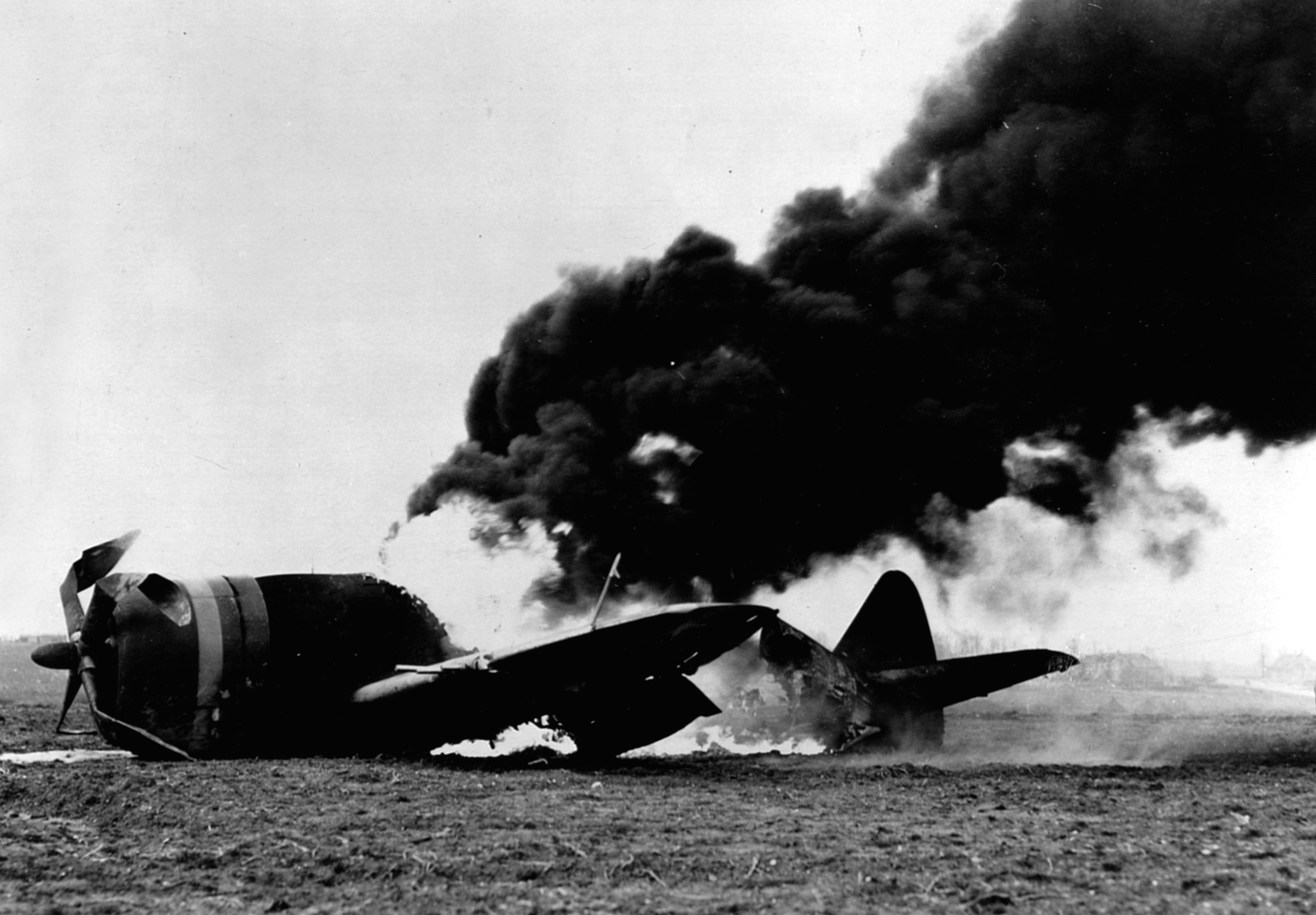
All sought cover except Sergeant Dave Hutchins, who was seated on the outdoor latrine reading the Stars and Stripes when he heard machine guns. Without hesitation, he dived into the latrine. From the muck, he watched 16 Me-109s coming straight for him. Major George Brookhart, the 386th’s commander, was sitting in the officers’ latrine. He alertly dived into a snowbank, pants hanging around his ankles.
Corporal Irving Wassermann of the 387th Fighter Squadron was towing a pair of trailers, each loaded with a dozen 500-pound bombs. He could not hear the oncoming planes but saw bullets stitch up the ground. He leaped into a foxhole and watched a passing Me-109. As he took cover, he remembered that it was his 21st birthday.
JG 53 “Ace of Hearts” hurled only two-thirds of its Me-109s at Metz-Frescaty, but those that made it got a warm welcome. An antiaircraft gun smashed a German cockpit, and the Me-109 smacked into the runway, rolling along the tarmac and hurling the pilot’s body away from the plane. Two ground gunners ran out and grabbed the pilot’s boots as souvenirs. Another Me-109 provided gruesome souvenirs. The plane crashed and decapitated the pilot, but a ground crewman coolly unfastened the pilot’s wristwatch.
On the other hand, Oberfeldwebel Stefan Kohl, on his first mission since being hospitalized in August, was luckier. The ground fire of .50-caliber machine guns riddled his Me-109, so he bailed out over the French hamlet of Marly. American troops hauled him to Metz-Frescaty for interrogation and found Kohl “cocky and insolent.” A fluent English speaker, Kohl refused to be photographed until he had combed his hair and shined his boots.
Nobody was killed at Metz-Frescaty, but Corporal Emanuel Catanuto gained a Soldier’s Medal by rescuing Corporal Lee Weldon from a blazing P-47 and dragging him away from it 30 seconds before it exploded. Catanuto had already won a Bronze Star and Silver Star serving with the 45th Infantry Division two weeks earlier, before his transfer to the Army Air Forces came through.
Other defenders at Metz-Frescaty were equally brave. Staff Sgt. John Lawless and Sergeant Olin Holcomb ignored enemy strafing, grabbed fire extinguishers, and doused a burning bombed-up P-47 before it exploded. Staff Sgt. Gordon Hurt and two pals powered up a P-47 next to a burning fuel truck and drove the plane away from the inferno. All received Soldier’s Medals.
Abruptly, the attacks subsided. All across Belgium and The Netherlands, German FW-190s and Me-109s pulled up from their targets, struggled back into formations where possible, and headed east to the Fatherland. The trip home was not easy. Feldwebel Werner Hohenberg of JG 2, a 200-mission veteran returning from St. Trond, was shot down by antiaircraft guns and pancaked in a field. JG 2 counted 33 pilots lost, 23 of them killed or missing, 10 prisoners, and four wounded. That was nearly 40 percent of JG 2’s strength. Their attack on St. Trond-Brustem, by comparison, had destroyed only two P-47s and damaged 14—with no human casualties. All the damaged P-47s were ready to fly in two days.
JG 6 had suffered an equal disaster at Heesch, 24 planes lost—a record for the opposing 126 Wing in a single day’s combat. The Germans had shot down three Spitfires and put a single bomb hole in the roof of 411 Squadron’s dispersal. JG 26 and JG 54 had done badly at Brussels-Grimbergen, too. JG 26 lost 12 planes, and III/JG 54 lost 10 of its 17 pilots. On the way home, III/JG 54 ran into British Spitfires, which shot down five FW-190s, including Hauptmann Willi Bottlander, the squadron leader. The airfield, by comparison, had lost one B-17 and one P-51. The Luftwaffe also blasted two hangars, 12 motor transports, and two fuel tankers, while killing one airman.
JG 11 counted 23 planes and 42 pilots, 40 percent of its strength, lost to Asch’s American defenders, including its commander, Oberstleutnant Gunther Specht, and Hauptmann Horst von Fassong, who commanded III/JG 11. In return, the Germans had slightly damaged four P-51s. Not one American plane fell in combat, and the Americans did not suffer a single casualty. For the feat, the 478th Fighter Squadron received a unit citation.
JG 1 headed home having lost 24 pilots, 12 killed, six captured, one wounded, and five missing—one-third of its strength. These pilots did destroy 25 Spitfires at St. Denis-Westram, the American B-17, and the Stirling awaiting Mike Shaw’s test flight, but JG 1 commander Herbert Ihlefeld was enraged. He considered the operation a total waste.
The attack on Volkel had been a disaster, too. JG 6 lost 32 fighters, including its commander, Oberstleutnant Johann Kogler. Hauptmann Ewald Trost, the commander of I/JG 6, was shot down and taken prisoner, while Major Helmut Kuhle, commander of III/JG 6, was killed.
Things went little better for the Luftwaffe at St. Denis-Westram, where five of JG 1’s most experienced fighter pilots were killed. JG 1 lost 19 pilots. The defending Poles suffered only two deaths, Flight Lts. Walclaw Chojnacki and Taduez Powierza, both from 308 Squadron. Some 25 Spitfires, one Stirling, and a B-17 were destroyed.
Gilze-Reijen was another Luftwaffe failure. One Typhoon was destroyed, another damaged, one Anson and a P-51 shot up, and seven airmen wounded. The Luftwaffe lost five pilots and five planes, including an Arado 234 jet.
Heesch was a botched attack, too. JG 6 shot down three Spitfires, but two of the 126 RCAF Wing pilots walked away and the third suffered minor injuries. In return, the Canadians shot down 24 German aircraft, which included 10 officers, three squadron leaders, and the JG commander, Oberstleutnant Johann Kogler. Both Kogler and squadron leader Hauptmann Ewald Trost were taken prisoner. The only damage to the base was a hole in the roof of the 411 Squadron dispersal hut.
Le Culot (A-89), home to the 36th U.S. Fighter Group, had the easiest time of all. The airfield was the target for JG 4, and the squadron’s Ju-88 pathfinder was shot down right away. The 60 fighter pilots got lost, scattering around the Western Front. Half of their planes did not return.
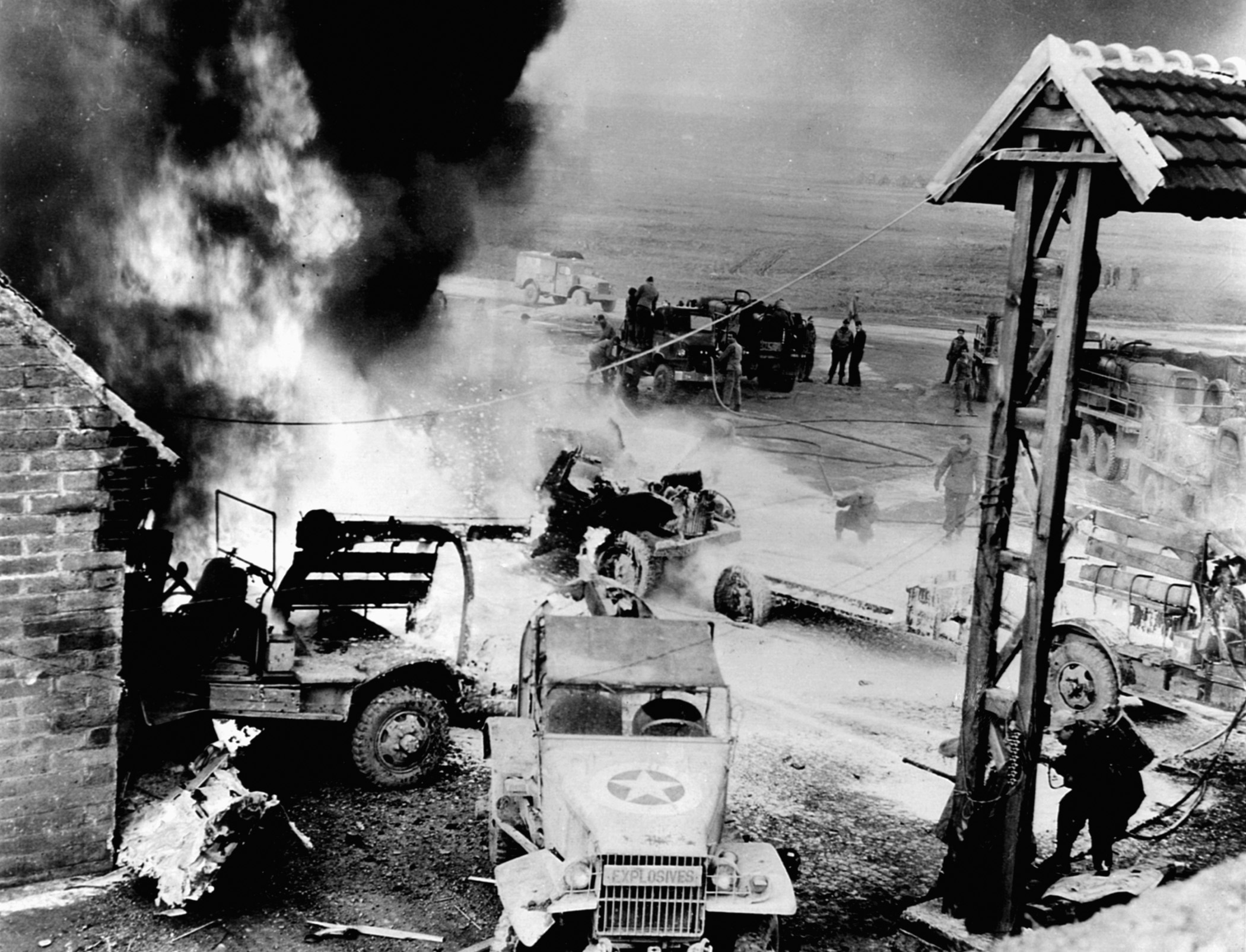
Some attacks had been highly successful. At Eindhoven, a number of Allied aircraft were lost. An entire squadron of Typhoons was written off. In all, Eindhoven lost 50 Typhoons, 20 Spitfires, 11 Wellingtons, two Ansons, two Austers, and a B-17. Five pilots and 40 members of the ground crew were killed. More than 145 men were wounded. JG 3, which hit the base, lost 22 pilots out of 70 attacking. While engineers got the runways clear by midafternoon, it was not until mid-January that things were back to normal at Eindhoven.
JG 26’s attack on Brussels-Evere was also fairly successful, destroying 11 Spitfires, Prince Bernhard’s Beechcraft, Field Marshal Montgomery’s C-47, and 11 motor transports for a loss of 20 pilots. Brussels-Grimbergen was less impressive, one B-17 and one P-51 destroyed for a loss of 13 pilots.
Gefreiter Werner Molge, streaking home, got separated from his buddies and overshot his base at Nordhorn. On his last fuel, he landed at III/JG 6’s airfield. A half-track towed the FW-190 off the runway. The base had no fuel for his plane. They flew Me-109s, which used B4, not C3 gasoline.
Brussels-Melbroek was also a success. Thirty minutes of German strafing left 14 Wellington bombers, seven Harrow transports, six B-25s, six Mosquitos, and three Spitfires destroyed. The attackers, from JG 27 and JG 54, lost 30 planes out of 60 sent in.
Metz-Frescaty faced JG 53’s attack and lost 22 P-47s and 11 more damaged. But the defending American gunners shot down 14 enemy fighters. The III/JG 53 lost all nine Me-109s in the air to American P-47 fighters. All nine pilots, including Unteroffizier Karl Goller, who rammed a P-47, were able to bail out.
Wrecked German planes and dead pilots lay all around Metz-Frescaty. Unteroffizier Herbert Maxis’s remains were found a month after the raid. Feldwebel Johannes Muller succumbed to his burns in a U.S. hospital the day after the raid. Unteroffizier Hots Pechchardscheck was luckier. He got his crippled Me-109 home. After the raid, only 30 of JG 53’s fighters were left serviceable, while not one American pilot suffered even a scratch.
JG 4 and JG 11 hit Ophoven (Y-32) purely by mistake, damaging seven Spitfires and wounding three men. The attackers lost seven fighters. JG 2 and JG 4 did even worse at St. Trond-Brustem (A-92), losing 15 JG 2 pilots before even reaching the target. In the battle, JG 2 lost 21 more pilots. JG 4 lost four pilots. Among the German dead was II/JG 2’s boss, Hauptmann Georg Schroder, who had 108 missions under his belt, and III/JG 4’s commander, Oberstleutnant Albert Druschel, who had 800 missions and a huge reputation from Russia as a ground attack ace. Germans destroyed less than a dozen P-47s and did not inflict a single casualty.
At Ursel (B-67), the final tally was JG 1’s destruction of one Mosquito, one B-17, and two Lancasters, all under repair, for two FW-190s destroyed. There were no casualties.
The carefully planned attack on Volkel (B-80) by JG 6 was also a disaster for the Luftwaffe. Only a handful of German planes hit the base, damaging a few Tempests. The defending flak and 486 New Zealand Squadron took out six German pilots, including fighter wing commander Johann Kogler, and the commanders of I/JG 6 and III/JG 6, Hauptmann Ewald Trost and Major Helmut Kuhle.
Woensdrecht (B-79) was also a failure, but for both sides. JG 77 buzzed the base to no result, but the defenders did no damage. Maldegem took a beating, 11 Spitfires destroyed for a loss of three Me-109s.
At Eindhoven, the bombing was over by 10 am, but not the explosions, as rockets and jerry cans of fuel continued to explode. RAF ground crewmen doused fires and hauled in captured Luftwaffe pilots. FO Andy Lord of 438 RCAF Squadron found a wrecked Me-109, dead pilot lying in it.
While ground crews hosed down fires, medics tended the wounded, and pilots debriefed their battles, phones were ringing at 83 Group Headquarters. Air Vice Marshal Harry Broadhurst was not going to let the German attack intimidate him. The best answer to the Germans and boost for morale would be an immediate counterpunch, and 2nd TAF’s boss, Air Marshal Sir Arthur Coningham, agreed. Broadhurst ordered his senior commanders to get everyone airborne. He told the pilots to ignore radio silence and talk as much as possible.
So did General Elwood “Pete” Quesada, the boyish airman who commanded the Ninth U.S. Air Force’s 9th Tactical Command. An exponent of close air support, he was angered by the German daring and reports of Nazi atrocities in the Ardennes. He quickly hurled his planes against German tanks to let the Nazis know who had air superiority. Allied fighters engaged the retreating Germans and inflicted more casualties, which the Luftwaffe could ill afford.
At the Luftwaffe’s airfields, the black men waited for their pilots to return. Gradually, the surviving Me-109s and FW-190s flopped down on their bases. At Plantlunne, Hauptmann Walter “Count” Krupinski and his III/JG 26 returned, very pleased with themselves. The gruppe had lost only four pilots out of 29. Krupinski took his pilots to the officers’ mess for a gala lunch, beginning with several rounds of schnapps.
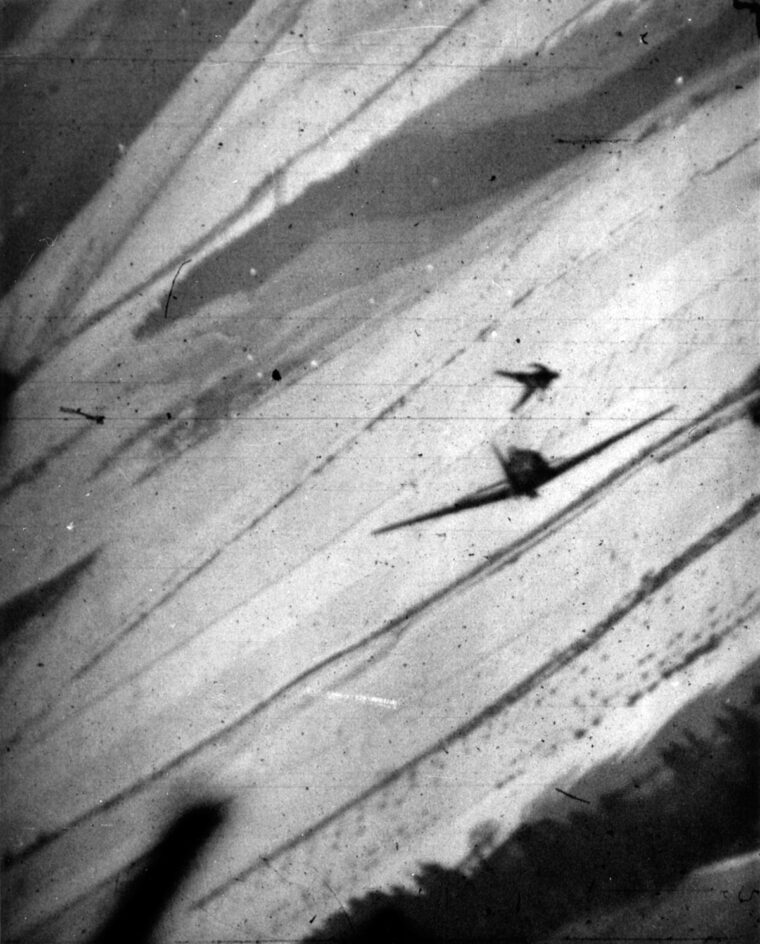
They were the only German squadrons in a celebratory mood, despite the Berliner Morgenpost’s headline the next day, which read, “A Major Success for Our Fighters.” While Goebbels’ controlled press spouted absurd victory claims, admin officers began ticking off the casualty bills. More than 151 Luftwaffe pilots were dead, including some of the most experienced veterans.
Whole Geschwaders were out of the game. JG 77 took off with more than a hundred planes. Only 30 found the target at Antwerp-Deurne. There they knocked out two planes, losing 11 pilots.
JG 26’s pilots claimed they destroyed 120 planes at Brussels-Evere and Brussels-Grimbergen. In actuality, JG 26 and JG 54 destroyed 13 planes at Brussels-Evere and two more at Brussels-Grimbergen, losing 33 pilots. Only seven of the 17 JG 54 planes that attacked Brussels-Grimbergen returned to base.
JG 4 lost 17 pilots out of 60. Major Gerhard Michalski had told his pilots before the raid that if they did not carry out the mission with determination he would send them back to finish the job. Now, studying the casualty lists, he realized he could not do so. The Luftwaffe had suffered one of the most catastrophic defeats in its history.
The Allied airmen had a simple name for Bodenplatte. They called “The Hangover Raid,” connecting it to New Year’s Day and the effects of too much celebration. In a short time, they had more to celebrate. Lt. Gen. Carl “Tooey” Spaatz, Maj. Gen. Hoyt Vandenberg, and Brig. Gen. Pete Quesada descended upon Asch and passed out medals and handshakes to airmen and ground crews.
Also celebrating was Reichsmarshal Hermann Göring, who presented the Bodenplatte strike to Hitler as a complete success, showing the Luftwaffe’s determination in the face of catastrophe. The fraudulent claims were soon obvious. The retreat from the Bulge was continuing, and so were Allied air attacks on the front lines.
On January 14, Allied fighters shot down 184 more German aircraft. Black Sunday put the Luftwaffe out of business. The next day, Hitler left Adlerhorst to return to Berlin with the Bulge offensive, a total disaster, and Soviet tanks advancing on the Oder River.
Peltz was fired as boss of what was left of Jagdkorps 2; it was academic now, anyway. There were plenty of planes left for the Luftwaffe to fly, but few pilots and even less aviation gas. The Luftwaffe had to yank 221 pilots from the overtaxed Eastern Front to replace their Western losses.
Bodenplatte’s bottom line was harsh—300 planes destroyed, 85 of them shot down by German flak; 151 pilots killed or missing; 63 taken prisoner. Among those killed or missing, two JG commanders, 14 Gruppe commanders, and 64 squadron commanders, the heart and soul of the Luftwaffe’s fighter command.
By comparison, the Allies lost about 300 aircraft on the airfields, and 70 more in dogfights overhead. While the material losses were great, very few pilots and ground crewmen died in the attacks, with only 40 killed and 145 wounded, 11 of the dead being pilots. The efficient Allied supply system replaced the lost aircraft, ground crews repaired the battered buildings and shoveled wreckage off the runways, and victorious pilots got back to work or got new mounts.
Flying Officer Ed Flanagan of RCAF Squadron 440 recovered from his wounds in a month and got his wedding leave 30 days later. On February 10, he married his fiancée, Renee Taylor, at Colgar Parish Church in Yorkshire. They remained together until his death 50 years later.
At Metz-Frescaty in France, Major George Brooking, the U.S. 386th Fighter Squadron’s commanding officer, who had been rudely bounced off the latrine by Bodenplatte, kept checking on his captive: the arrogant Oberfeldwebel Stefan Kohl. The Luftwaffe pilot had spent the afternoon of January 1 and all of January 2 sneering at the wrecked P-47 Thunderbolts on the tarmac.
“What do you think of that?” Kohl would sneer at his captor each time, pointing at the wrecked planes and twisted aluminum. Brooking resisted the urge to punch Kohl in the nose.
Now, on January 4, Brooking brought Kohl to his office and told Kohl to look out the window. The wrecked planes were gone. Out on the flight line stood 10 new Thunderbolts, fresh from American factories and, gleaming in the winter sunshine.
“What do you think about that?” Brooking asked, pointing.
Kohl stared at the planes, then at the floor, and then turned to Brooking, his voice quieter and thoughtful. “That is why you are beating us,” Kohl said.n
Author David H. Lippman writes a day-by-day history of World War II for a Web page from his Newark, N.J., home. He is a veteran of the U.S. Navy.
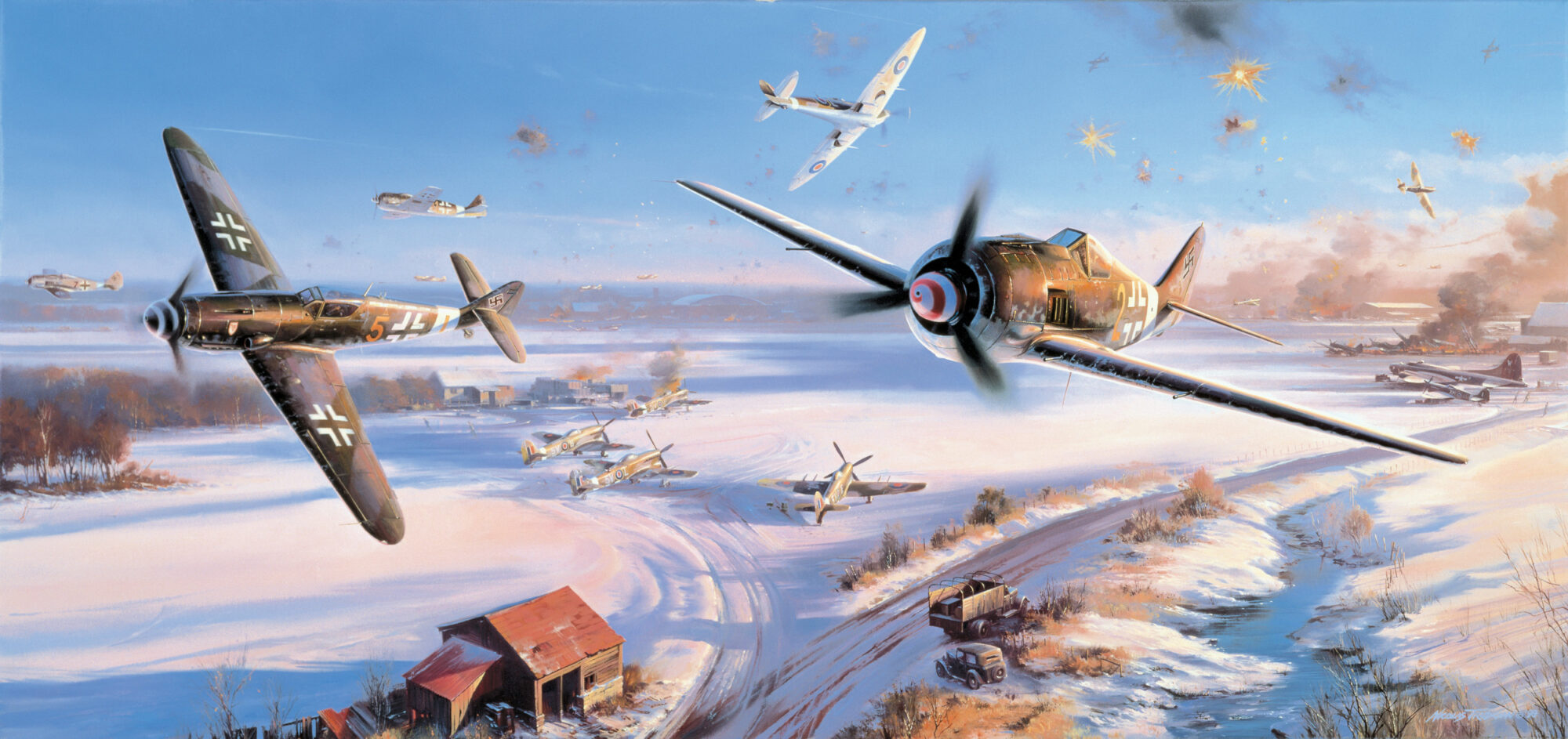
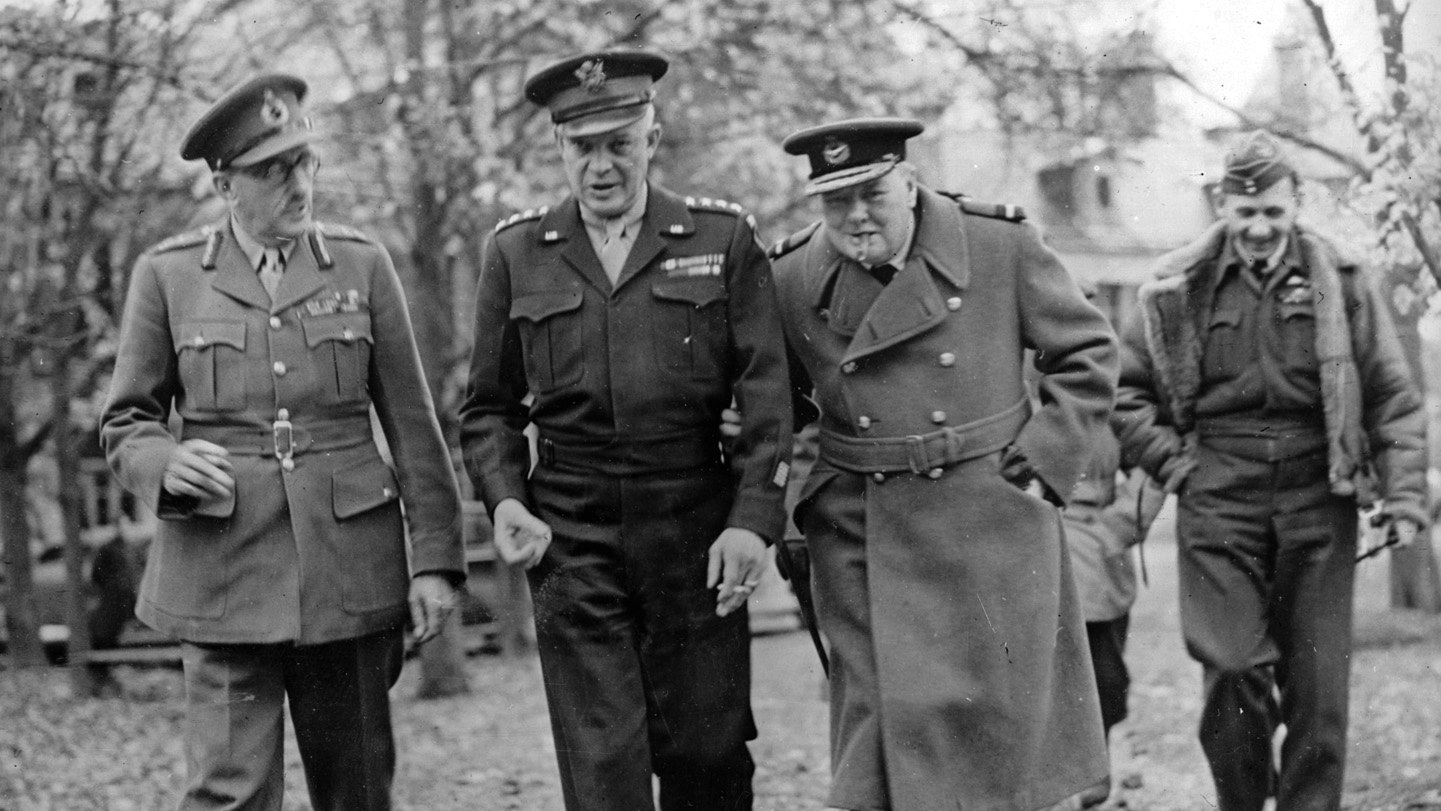
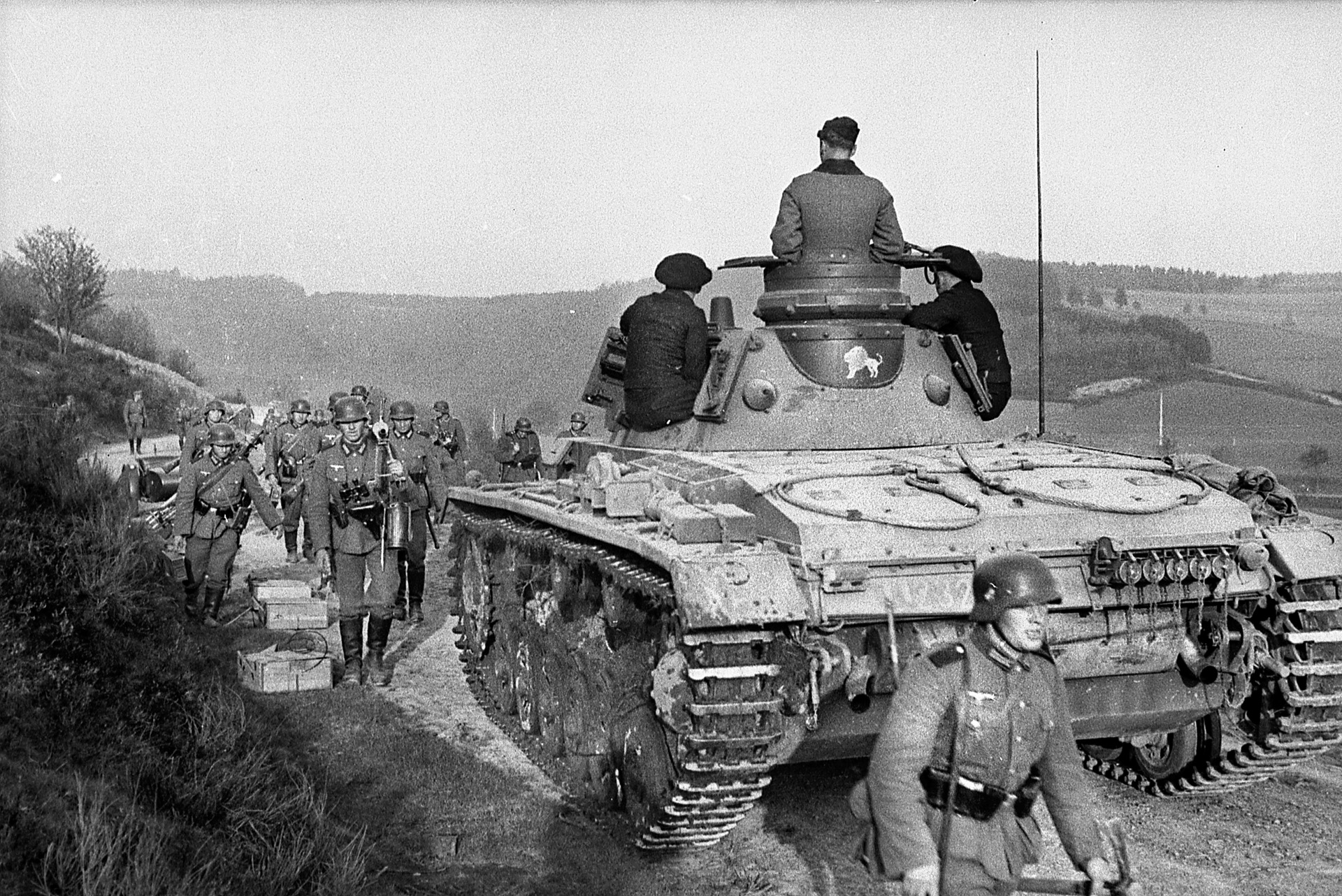
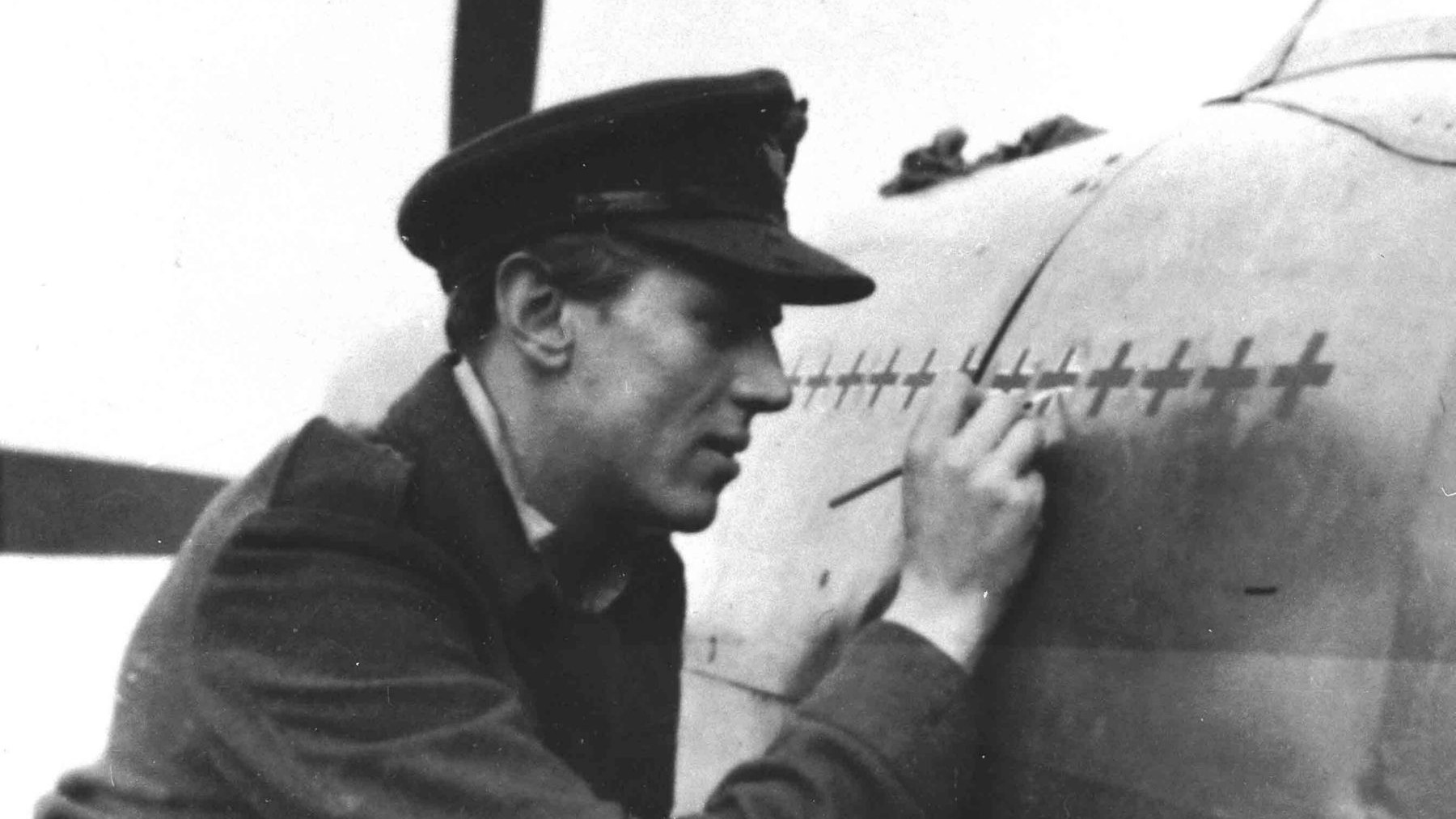
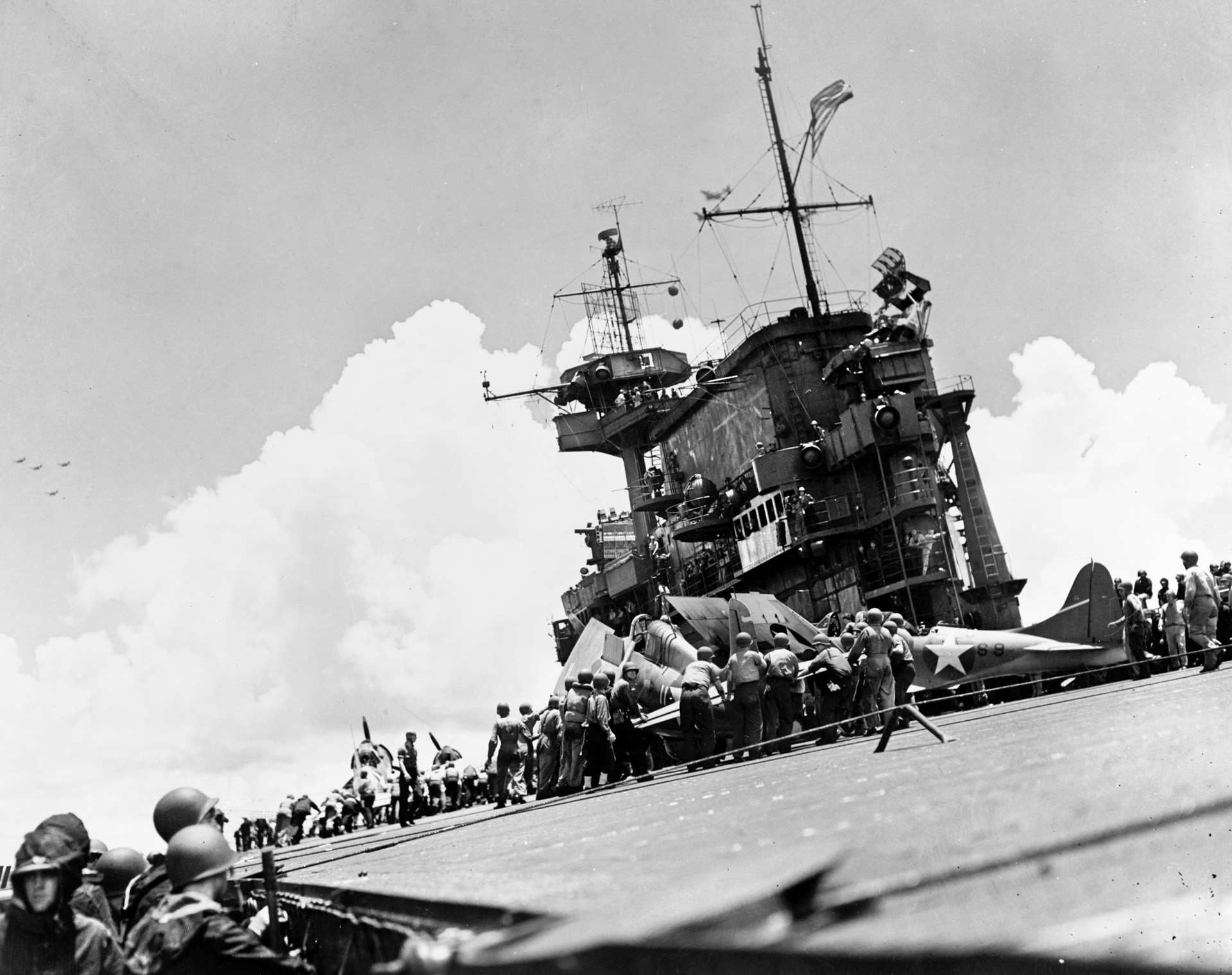
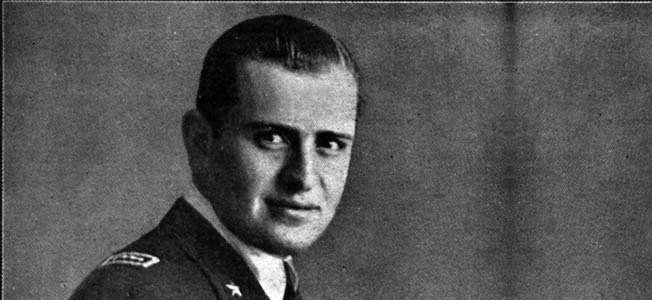
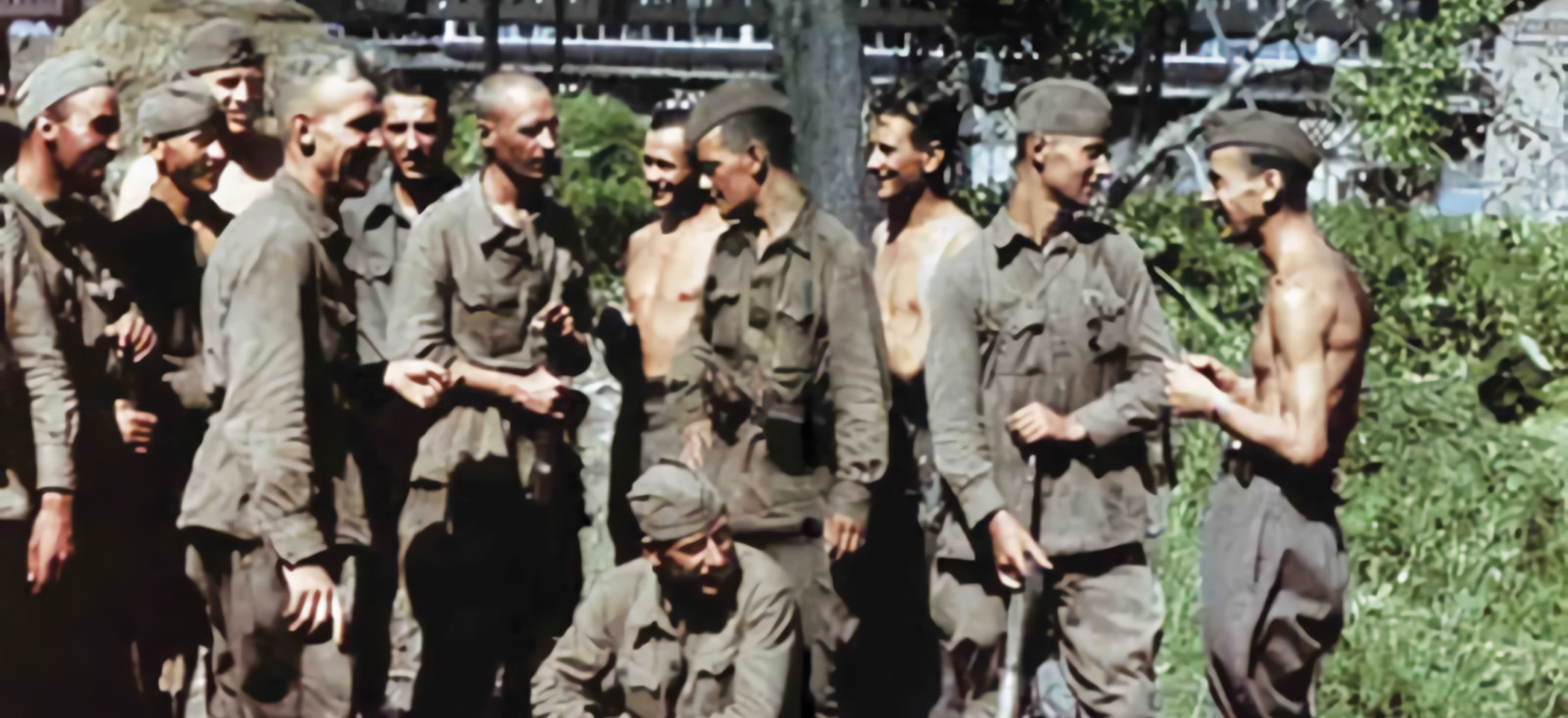
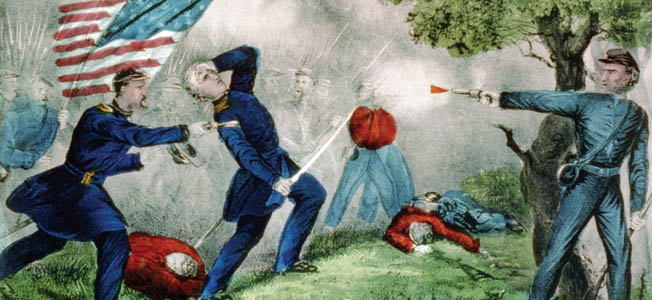
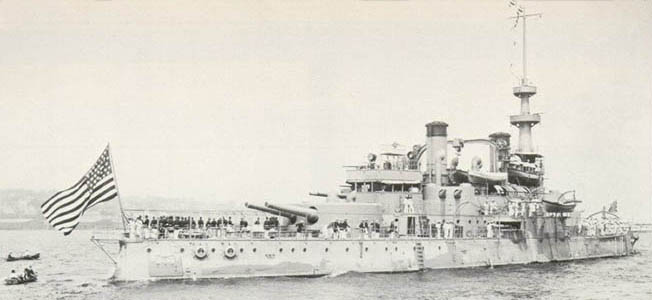
My Dad, Sgt. John Stringer, was a P-47 armaments specialist in the 53rd Squadron, 36th FG, based at Le Culot. Hopefully, his pilots got into the action, but the base escaped detection by the Luftwaffe that day.
I enjoyed writing this story.
It was a bizarre moment in World War II, a last “death or glory” ride for the Luftwaffe, and is not well-known, because it was so late in the war, heavily involved Canada, and had minimal impact.
I enjoyed the ending.
When Field Marshal Montgomery’s plane was destroyed, Gen. Eisenhower generously provided Monty with his own C-47 as a temporary replacement.
When Monty commanded the 8th Army in Tunisia, he made a bet with Ike over when his tanks would seize Sfax. Montgomery often made small bets with various officers, and recorded them in his commonplace book. At stake was a US Army Air Force B-17. Ike took the bet, disbelieving that Monty would take Sfax in time and seriously demand a Flying Fortress.
Ike was wrong.
Montgomery took the town and demanded the B-17, with an American crew. Actually, he had a serious reason. With its 10 .50-caliber machine guns, great range, and large capacity, it could carry him, his luggage, and immediate staff from Point A to Point B around the Mediterranean Theater with great efficiency.
Eisenhower paid the bet and a B-17 with a USAAF crew was duly assigned. Montgomery was delighted, and he tooled around North Africa, Sicily, and Italy in it, with RAF Spitfire escort, until it cracked up in a hard landing. After that, Montgomery used a C-47 Dakota, which were in plentiful supply, in Northwest Europe, where distances were shorter and did not require a B-17.
Too bad it cracked up — I’m sure it would be in the Imperial War Museum today, along with his trailers and personal Grant tank.